Category: Nezaradené

He exchanged a photo for sound, the Netherlands for Finland, the comfort of home for Malý Berlín: An interview with Sjors, our resident
Another of the artists who spend time in the Malý Berlín cultural center and create at the same time is Sjors Hoogerdijk. The Dutchman living in Finland works mainly with the sound medium. In the coming days, he is preparing two interesting events. He tells more about them, about himself and his work in the interview.
We’re sitting here in a studio where you work. What are we looking at right now? What kind of projects are you currently working on?
You can see the piece I’m building. It’s an audio installation. It records sound—sometimes voices, sometimes silence—and then plays it back on a loop. What you’re hearing now is the system feeding back into itself.
That’s quite a specific and unusual medium. Can you tell me more about your background and how you ended up working with audio? Not just this piece, but more broadly—how did this become your artistic direction?
I originally studied photography. Even then, I was already doing what you might call “weird” studio photography—constructing scenes, playing with materials, and experimenting a lot with Photoshop and the structure of digital files. Later, when I got into art school, I also started painting. Then I moved into installations with mechanical elements—using motors to create movements, making objects swing or bump into each other in a sort of chain reaction.
Eventually, I became interested in sound. What really struck me was how similar sound is to photography—at least in the way I understand and work with files. In both cases, it’s about capturing and manipulating data, from silence to noise or darkness to light. My first audio works actually involved light sensors: the pitch of the sound would change depending on the amount of light the sensor detected. So when someone walked by, the pitch would shift. It became this semi-interactive experience.
So audio, for you, isn’t completely different from photography or painting—it’s just another way of expressing similar ideas?
Exactly. Even in my photography and painting, I was always interested in technical aspects—revealing the materiality, the texture of paint or the grain of a photo. With audio, I’m doing something similar: I’m trying to reveal the texture of sound, its graininess, its physical presence.
Let’s go back to the beginning. You mentioned you studied photography, but was there a specific moment when you realised, “Yes, sound is going to be my thing”?
Yes, I think that turning point came when I got to know a Norwegian friend of mine, Eirik Rønneberg. He was already deeply involved in noise music and performance art, and he taught me a lot—especially about using sound in a raw, DIY, almost punk way. Around the same time, I was organising shows with friends, inviting bands from across the country. Putting on concerts and creating spaces for people to gather and experience something live came very naturally to me.
Then I started performing noise concerts myself. In those early performances, I’d use a single object to create sound—like a windscreen wiper motor connected to a piece of wood with a contact microphone. I could touch it in different places and get it to “sing” in a way, kind of like a cello. Gradually, I moved toward creating works that didn’t need me to perform them. I wanted them to exist on their own, to allow the audience to engage with them without my presence or explanations.
So the installation becomes self-sufficient—the audience interacts with it directly, without needing you to interpret it for them?
Exactly. I think it’s important that people can encounter a work and come to their own conclusions. They can think it’s crap, or beautiful, or something in between. The point is that they experience it on their own terms, not just through my ideas or descriptions.

When I first came here—few days ago—it reminded me of a parent’s garage. There are so many cables and electrical components everywhere. Can you tell me more specifically what kinds of materials or devices you usually work with in your performances and installations?
Yeah, it does have that garage vibe! I mainly work with electronics—it’s the umbrella term. I started out using things like guitar pedals and contact microphones, which are mics that pick up vibrations from whatever surface or object you attach them to.
But guitar pedals are expensive, fragile, and tend to break, so eventually I started repairing them. That led me to wonder how I could build them myself—and I found all kinds of schematics online. Once I figured out how to make them, I began using them more intentionally in my work.
As I gained experience, I started designing my own circuits, thinking creatively about what I wanted a piece of electronics to do. I began visualising two objects and figuring out what kind of circuitry could go between them—how to transfer sound, how to manipulate it in interesting ways. That kind of thinking became central to how I work.
How would you describe your work—or yourself as an artist—in just one sentence? For example, someone might say, “I’m an adventure photographer.” What would you say?
I usually say I make sound installations or audio installations. But honestly, “installation” is kind of an art historian’s word—it doesn’t really explain much.
A better way to put it would be: I make sculptures that produce sound. Or perhaps I’d say that I’m constantly translating one thing into another. I’ve become quite good at fixing things—figuring out how to tie two elements together, sometimes literally with a piece of rope. That’s still a big part of my process: identifying a relationship between two things and then finding a way—often a clumsy, visible, hands-on way—to make that connection happen.

You’re originally from the Netherlands, but now you live in Finland. That’s quite a distance. What brought you there?
I did my bachelor’s degree in the Netherlands. One of my friends is Finnish, and through her I met my girlfriend—who’s also Finnish. I eventually moved to Finland to be with her and to do my master’s degree. That was over five years ago, and now we’ve really built a community there. It feels like home.
Can you tell me a bit more about your education? You mentioned photography—was that in high school or later?
I started with photography at a vocational school—it wasn’t a traditional university, more like a school focused on practical skills.
So something like an advanced high school?
Yes, exactly. From there, I moved on to an art school, where I began with painting but later returned to more technical work.
And your master’s degree?
After spending a few years working on art projects in the Netherlands I did my master’s in Finland.
And now you are here. I think you’ve been in this residency for about a month, maybe longer? How has it been for you?
I’ll be here for a total of two months, and right now I’ve been here for about five weeks. So yes, we’re getting close to the end. It’s been really nice—I adore the city. I enjoy walking around, watching spring arrive in the parks, and seeing all the different trees bloom.
And it’s been very special for me to be able to fully focus on my work. I’ve tried to structure my time with solid blocks of studio work—spending whole days soldering, reworking old ideas and redesigning things. It’s not about rushing through a project from A to Z, but rather building something with lasting value. Creating a solid foundation for future works.

This isn’t your first residency, right? You’ve done similar programmes before?
Yes, but never one as good as this.
What makes this one better? What’s the biggest difference?
I think it’s the trust they place in the artist. You come in, and they say, “Here’s your space—now work.” There isn’t a rigid schedule or a detailed plan to follow. That kind of freedom is rare.
In contrast, other residencies have been more structured, like art camps. One of the better ones I did was in a repurposed school building in the Dutch countryside. But even then, I was biking back and forth from home, splitting my time between working there on weekends and doing my regular postal job during the week.
So basically, you’d say this place gives you more freedom than usual. You’re not told exactly what to do—you just arrive and create?
Exactly. Which is both exciting and a little intimidating—having no guidelines can feel overwhelming at first.
You’ve got two events coming up—one is an open studio. What can visitors expect when they come next week?
They’ll be able to see the work and interact with it—it is getting close to finished now. Ideally, I’d like them to play around with the pieces, explore them. I’ll be there too, so they can ask me anything, and I’ll explain how things work or what inspired them.

And the workshop?
For the workshop, I want to show people what sound art can be—and how simple it can be. I’ll demonstrate a few different recording methods, different ways of listening and visualising sound…
What will be the main focus? What can people expect to learn or experience if they attend?
I’ll start by explaining what I think sound art is, and I’ll show some examples. Then we’ll try making something ourselves—together. It could be as simple as banging on a table or listening to the inside of a computer using a contact microphone and discovering what kind of sounds it makes.
Basically, I want to introduce people to a different spectrum of sound. It’s about showing how to play with sound, how to explore it creatively.
So would you say it’s more for beginners or people who already have some experience with sound design or sound art?
It’s definitely aimed more at beginners. If someone is already very advanced in sound art, they probably won’t find it that interesting. I really want to start from the basics—what sound art is, what it can be, and how it connects to other art forms.
So it’s a bit like an introductory drawing class, just with sound instead of pencils?
Exactly. A sound sketching class, if you will.
So it’s really for anyone who’s curious—someone who maybe wants to try something new and experiment a little?
Yes, that’s the idea. It’s for people who are open and a bit curious.For those who want to try and learn something new.
Ján Janočko
Photo: Michaela Holota Lehoczká, Laura Soltan

Translator Kateryna Matviichuk Talks About Her Three Months in Residence and Her Love for Slovak
For the first time, a translator joined us as part of the residency program. Kateryna came from Ukraine with the goal of translating a Slovak book into her native language. What fascinates her about Slovak, what she enjoys about it, and how she tackled Slovak literature are all revealed in this interview.
Katka, why did you choose Slovak out of all the languages in the world?
In Ukraine, we have a different educational system than in Slovakia. We finish high school at 16 and then have to make one of the most important decisions of our lives—choosing a major and field of study at university. At 16, I didn’t understand myself or the world very well, so I based my decision on one key priority—I loved reading, so my chosen field had to involve literature.
I was intrigued by the Slavic philology program because it offered the opportunity to study various Slavic languages alongside literature. It seemed like a good combination — interesting, practical, and useful. From a rich selection of languages, I chose Croatian and Slovak — they attracted me with their Balkan charm and… exoticism (laughs). Yes, believe it or not, neighboring Slovakia seemed exotic at the time because people were surprised and even puzzled by my choice: They teach this language here? And someone studies it? Why? What will you do with it?
But it turned out to be the right choice. I enjoyed studying the similarities and differences between Slavic languages, observing patterns of their development, and their mutual influences. After student exchanges in Croatia and later in Slovakia, I was very satisfied with my choice.
What do you enjoy most about Slovak, and what do you find the hardest?
This might sound strange, but I loved studying Slovak grammar and then constructing sentences like puzzles — word by word, sometimes comparing with constructions in Ukrainian or Croatian. It’s very satisfying to me.
My first challenge was mastering the accent. Since I started studying from textbooks and audio materials, I only realized during my student exchange in Prešov that Slovak isn’t spoken that way, and I had to retrain myself.
Another difficulty was understanding reflexive verbs. I had to accept that phrases like pomáhať si (to help each other) and kúpiť si (to buy for oneself) follow different logic. But now, reflexive verbs are one of my favorite topics, and I enjoy explaining them to others — it makes me feel like I possess rare knowledge that I can pass on.
Now, I’m more concerned about nuances in colloquial speech, dialects, phrases, and cultural context. I’ve attended stand-up performances in Slovakia twice. The first time, I understood everything and laughed along with the audience, but the second time was a disaster. Not because of the comedians, as the audience laughed heartily, but because I didn’t understand the jokes or often even the words. The tension gave me a headache, and I had to leave.

When did you start translating?
I began as a student. In 2013–2014, Croatian journalists visited Ukraine to make a documentary about the Revolution of Dignity (Euromaidan) and later about the start of the war. I traveled with them to border towns and helped with translation.
That same year, I attended a Belarusian alternative and rock music festival, Basowiszcza, in Poland. There, I learned it would be impossible to organize a similar festival in Belarus due to censorship and cultural and linguistic oppression. I discovered that Belarus was undergoing extreme suppression of the Belarusian language in education, media, healthcare, and other spheres — threatening its very survival. Motivated by this, I translated several Belarusian books into Ukrainian to support the language.
One book, The Language by Viktor Martinovich, was especially relevant as it’s a dystopia centered around a banned language, distributed illegally like a drug. Another was a philosophical novel, Marginalis, by Kirill Stasevich. I recall that during editing, I realized I had mistranslated nearly all the names in the text.
How do Ukrainians perceive Slovak?
Previously, reactions were mostly surprise — Why Slovak? — followed by questions like, Is it easy? Is it very similar to Czech? Since the outbreak of war, things have changed. People now say, Oh, you must be busy teaching Slovak. And it’s true — many Ukrainians have found refuge and a peaceful life in Slovakia. Now, people understand the importance of this language for our people and country.

Does Slovak have much in common with Ukrainian?
Both languages belong to the Slavic language family, though Slovak is part of the West Slavic group, while Ukrainian belongs to the East Slavic group. This means that many basic words share the same origins, and overall, lexical similarities between the two languages range from about 40% to 60%.
However, despite their shared roots, many words have changed over time due to influences from other languages. For example, Slovak has borrowed extensively from Hungarian, while Ukrainian has borrowed from Polish, Russian, and even Turkish.
Both languages share a similar grammatical structure, including noun, adjective, and verb declension. For instance, they both have gender distinctions (masculine, feminine, neuter) and grammatical number.
What is the hardest part of Slovak for you?
Speaking like a native Slovak rather than like a textbook. This requires constant interaction with Slovaks to learn all the nuances, slang, and cultural context. Watching videos or films can never replace live communication.
What was your goal during your residency in Malý Berlín?
My goal was to immerse myself in contemporary Slovak literature, read as much as possible, and select works that would interest me and appeal to Ukrainian readers. During my residency, I translated several stories from Dominika Moravčíková’s collection Dom pre jeleňa (A House for a Deer). I also spoke with the author, sought her advice, and learned more about the translator-writer collaboration.
So I accomplished everything I had planned, and I’m very happy about it.
How did you find out about this residency?
A friend told me about it and mentioned that I could still apply. At first, I was hesitant and confused because it had been a long-standing dream of mine to create an anthology of contemporary Slovak literature. However, with the start of the war, I had forgotten about all my past wishes, so this opportunity felt like a wonderful surprise and a reminder from my past.
How did you choose the texts you translated during the residency?
My goal was to create an anthology of contemporary Slovak short stories. Several criteria played a role in the selection process. It was important for me to translate works that resonated with Slovak readers, that were appreciated by both book enthusiasts and literary professionals, and that I found personally interesting.
I started by exploring works by four authors, but it was the fifth, Dominika Moravčíková, who really captivated me. That’s how I began translating her stories from Dom pre jeleňa. Since I aim to publish these translations in Ukraine, I also analyze what would resonate and appeal to Ukrainian readers.
My curator, Anna Siedykh, gave me a lecture on contemporary Slovak literature, which provided me with an overview and a list of authors and works to focus on.
Thanks to the residency, I also had the chance to meet publisher Koloman Kertész Bagala, who I think understands contemporary Slovak short stories better than anyone else. His recommendations and advice were invaluable.
How did you adapt to living in the center of Trnava?
That, too, was a long-time dream—living in the center of a beautiful, quiet European town, overlooking a peaceful courtyard that tourists occasionally visit. My mornings started with me sticking my head out of the attic window to look at the tops of plane trees and the city tower. I did the same before going to bed—it became a three-month tradition.
My phone is now filled with dozens of photos of that view in different weather and lighting. On Fridays or Saturdays, I’d visit the city market near where I lived, and I’d enjoy a walnut croissant right there.
The Nádvorie space is very inspiring—it makes you want to work, create, and come up with new ideas. The change of environment had a very positive impact on my productivity.

What did this residency give you?
It provided ideal conditions for studying literature. With access to libraries, I read a lot of Slovak works and could finally focus on translating. I also improved my Slovak by attending literary events in Trnava and Bratislava, where I had the opportunity to hear authors speak and meet them personally.
I also met Slovak publishers. I was pleasantly surprised by how many Ukrainian books are now being translated into Slovak—I keep seeing new releases in bookstores and hearing about public presentations. I want to ensure this exchange isn’t one-sided, which is why I’m eager to finish the anthology so it can find its place on the shelves of Ukrainian bookstores.
Will you return to Trnava someday?
Yes, I’d love to. This experience was truly unique for me.
What did you like most about Malý Berlín?
I loved observing the dynamic energy of the center, where something happens every day and the space attracts a diverse crowd. I saw teenagers jumping and shouting during rap performances, children creating their own animations, literature enthusiasts at the Ypsalon festival, and townspeople enjoying theater performances.
Organizing such a varied and vibrant program must be a challenging job, but it’s clear that everyone at Malý Berlín knows their role well.
Ján Janočko
Photo: Lívia Martvoňová
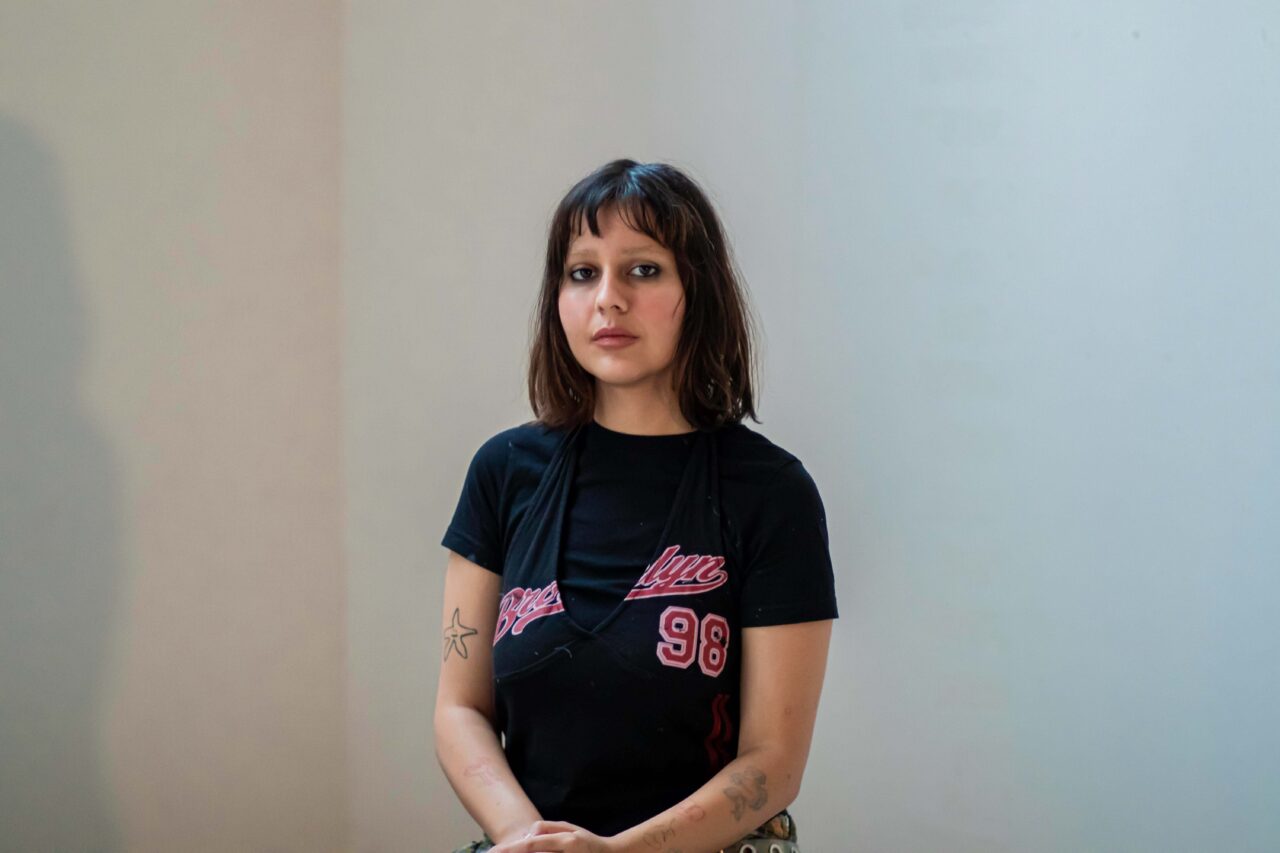
Malý Berlín is preparing another Open Studio: This time with the artist Sopiko
In the art studio at Nádvorie, we recently hosted Georgian artist Sopiko. This Thursday, November 21st, at 7:00 p.m., she will present her work to the public. Learn more about Sopiko, her journey, and what to expect at Open Studio in our interview.
Sopiko, what impressions will you take away from your residency in Malý Berlín?
I’m truly grateful for the chance to be an artist resident at Malý Berlín. Having the space, time, and a peaceful environment to focus on creating and connecting with others was such a gift. It was inspiring to work in a new place, experience a new country, and collaborate with a cultural space like this. This residency gave me a deeper understanding of my work and practice while opening up opportunities for meaningful conversations with the community. It also encouraged me to try new approaches and see my ideas in a different light. This experience will stay with me and continue to shape my future projects.
What has the residency brought to your life and what lessons has it taught you?
Residencies are such an important part of an artist’s life. Whether they’re short or long, they challenge you, shape your perspective, and push your practice in new directions. My two months at Malý Berlín were a complex, diverse, and deeply interesting experience. Working on my project within this set timeframe was both challenging and incredibly fulfilling — it taught me how to use time and space more intentionally. Beyond the work itself, interacting with the local community added so much depth to the experience. Getting to know the culture, art scene, and daily life in Slovakia was a significant and inspiring addition that will stay with me.
Were you afraid when you went to Slovakia? What were you most afraid of?
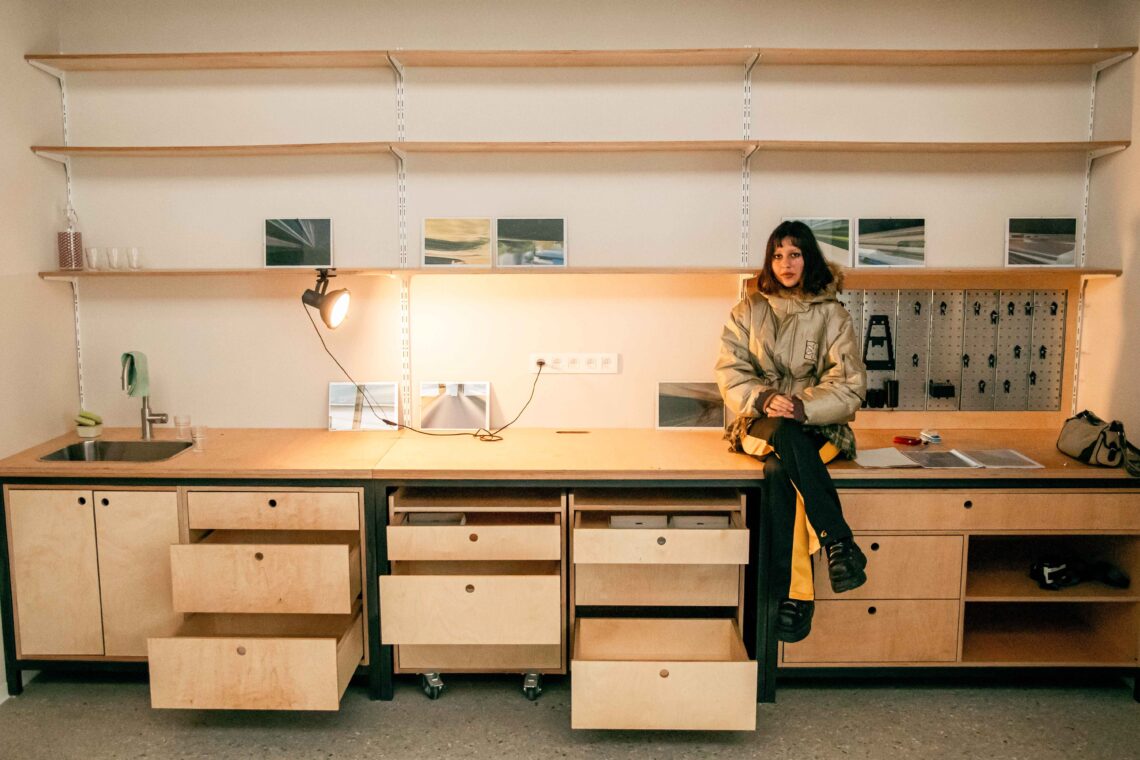
I don’t think I ever feel afraid of going to a new country and exploring it, whether it’s for work or personal reasons. So, no, I wasn’t afraid to come to Slovakia for this residency. Of course, there are always things to consider when you’re spending months in a new place. I thought about finding a safe space where I could feel comfortable, being able to express myself openly with people, and having the chance to fully experience life both through my work and as a person. Those were my main thoughts, but fear was never part of it—just curiosity and excitement.
How long did you stay in the residency at Nádvorie?
The residency lasted for two months, starting in late September and ending in late November.
What exactly did you work on?
During the residency, I worked on a project that explored various approaches through different mediums and concepts. The project was based on the idea of city scoring and urban planning, studying spaces through noise and understanding them as both a language and an act. I created a two-channel video: one channel captures the decibel levels in the city using an app on my phone, presenting the image alongside the data, while the other features text-based research written during the residency and footage of writing under a microscope. This visualizes the process of mapping and framing space through language and noise. I also developed a photo series by screenshotting spaces in Trnava, capturing only the transitions between points of movement. This created a kind of scoring of the city, devoid of a concrete narrative. Lastly, I composed a sound piece using a Georgian word that refers to both a space and a person, adding a linguistic and cultural layer to the work.
What was the most challenging part of the work?
There are always challenges when developing work, and I believe creation should be challenging. Being in an unfamiliar space was one of those challenges, but my curiosity and approach helped make the process easier. Of course, there were also challenges in deciding how the work would develop, how to connect all the information, and how it would be understood by others.

The open studio is coming up, what can visitors expect from this event?
At the open studios, I will present the project I developed during the residency. Visitors can expect to see a sound installation, a two-channel video, photographs, and texts. The exhibition will be a complete reflection of the topics and concepts I explored during my stay, offering an insight into both the process and the final outcome. It will be interesting, I believe, for visitors to see how a foreign artist reflects on their space and develops work in a different country.
Interdisciplinary artist based in Tbilisi, Georgia. She earned her BA in Visual Arts from the School of Visual Arts, Architecture, and Design at the Free University of Tbilisi. Through her research-based practice, Sopiko Sheitnishvili explores the intricate relationships between the Georgian language, urban noise, voice, and visual representations of sound. Her work examines how these elements shape and transform the experience of public spaces and investigates how language itself is continuously reshaped and oppressed through technological influences in modern environments, presented through a diverse range of media, including installations, sound works, writing, photography.
Ján Janočko
Photo: Lívia Martvoňová
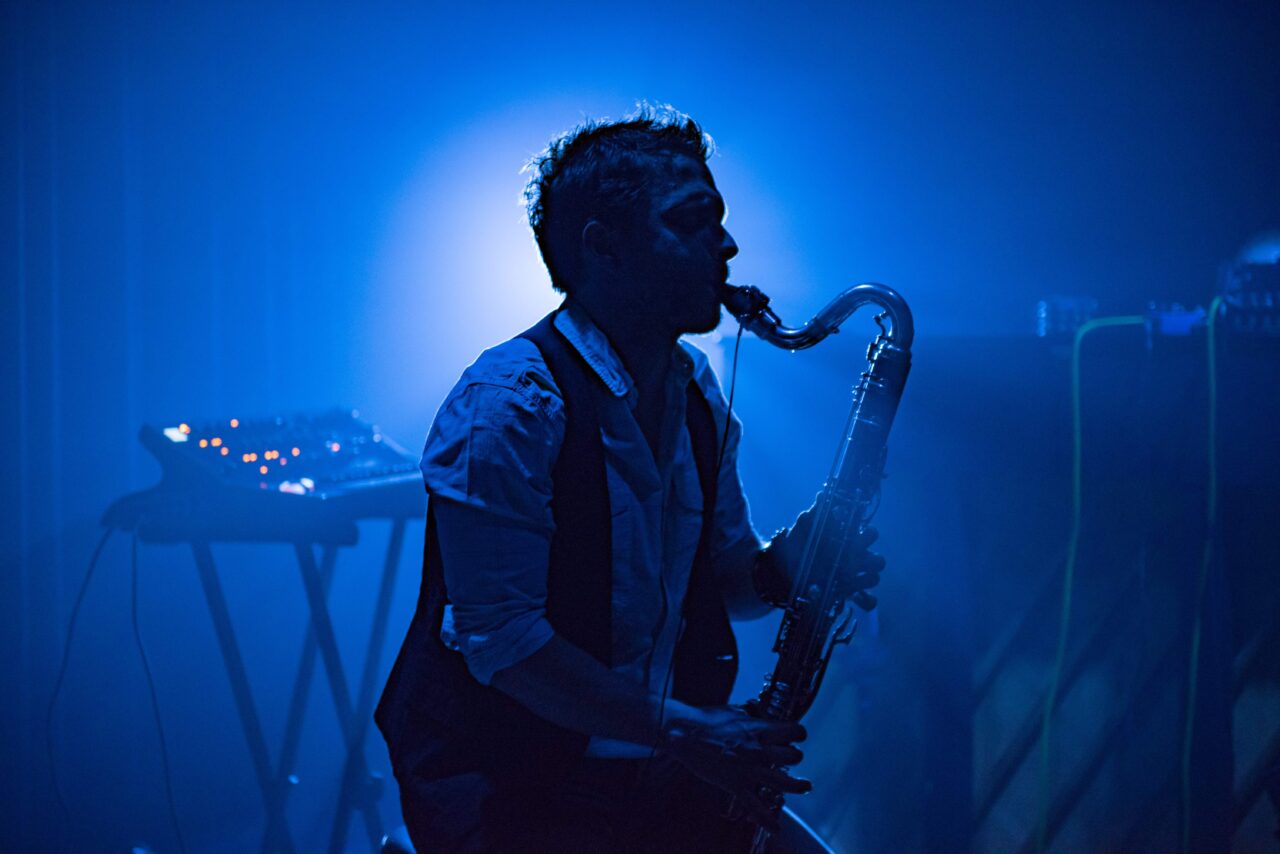
Gareth Davis will be featured in our next concert from the b minor cycle. In it, he will present compositions separated by 60 years
The series of concerts of contemporary classical music under the name b minor continues in the fall. Already on September 7, we will welcome another musician to Malý Berlín. Gareth Davis prepared interesting stories for the listeners, which he will play on the clarinet. It will be a journey through time full of memories, but also current topics. He reveals more in the interview.
We will see you soon in Malý Berlín. What are you most looking forward to?
I’ve done some great shows in Slovakia, but I’ve not been to Trnava. Being able to play in different places is something that I am always looking forward to. I am mostly playing music from the last 60 – 70 years which is, for me, a unique experience with the audience. The music itself is often less known, so being able to introduce it, share the experience and tell a story is fantastic.
Your path to clarinets was said to be quite interesting. Can you tell us more?
I now play only the low clarinets, and have done for quite a long time. My own taste in music is quite eclectic, and I’ve always had just as much interest in rock, electronic music and improvisation as I have in classical and contemporary classical. I do not know if my path was more interesting than other people, but maybe one thing that has been interesting for me is constantly trying to extend and challenge myself. Playing different or unexpected kinds of music, finding different ways to fit the instrument in a specific combination.

How has your relationship with music evolved over the course of your life?
I have been into many kinds of music from a young age. The first orchestra concert I remember going to was the music of Xenakis. I was probably around 7 years old. I’m not sure if there was a conscious choice in that or my parents simply decided it fit that week, but for me it created the idea of music being so many things from the start.
Over time I have found a way to play in things that I like, and this is sometimes a long process. Knowing when to wait can be difficult but also when you reach the point you have something you know you want to say and communicate with the audience, for me, the process makes much more sense. Contemporary music can seem abstract or ‘difficult’ but perhaps a lot of this is down to the ideas that are presented with it. Every day we hear sounds that, without context, would seem to make no sense. The context of our daily life gives them a narrative and this can make things thrilling. So perhaps my relationship is one of trying to find constantly new ways to tell stories.
Will you come to Slovakia alone or with the support of some musicians?
The two pieces I am playing are for solo bass clarinet and electronics. So I will be the only person playing an instrument, but I will be joined by the Czech sound designer Mikuláš Mrva. Mikuláš wrote the software patch to perform the pieces. A software patch is a series of instructions that tells the programme what to do at certain times. In the past, instead of using electronics, large analogue devices were used. For example, to repeat a sound in a concert, there would need to be a microphone recording what I play to tape, this would be repeated a few seconds later creating either a loop or kind of echo effect. Now there is software to do this, but in more complex pieces the software needs to be ‘told’ what to do. So while I am playing the bass clarinet live, Mikuláš is taking my sound, changing it, stretching it, cutting it, mixing it and sending it to different speakers to create a multi layer texture. The single instrument can, because of this, become a kind of ensemble.
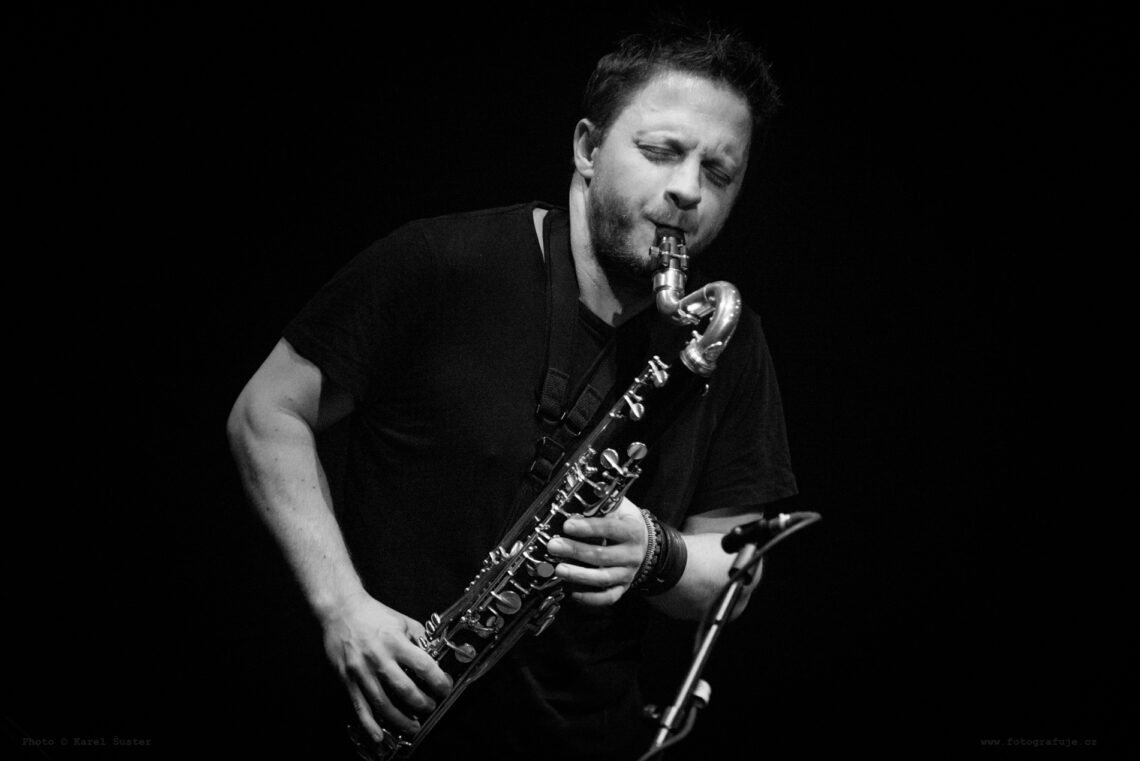
Can you please introduce the program of the concert?
I will play two pieces. Solo, by Stockhausen, was written in 1966 while Theatre of the Mind by Roland Dahinden, was written in 2021.
The piece by Stockhausen explores how a single instrument can become a stack of sounds, each layer slightly changed to create a sort of landscape.
The work by Dahinden is far more narrative. I premiered it at the festival in Ostrava in 2021 and it was written as a response to a huge number of people who were struggling with issues of mental health during the pandemic. In the Netherlands (I live in Amsterdam), the number of children having growing struggles was enormous. What Roland explores in this piece is the sensation of being ‘locked in’. The way in which thoughts start to circle in the mind, recreating, repeating, always evolving but still stuck. Sense comes and goes, sometimes fixated, other times a foggy blur.
What exactly can viewers (and listeners) expect?
These two pieces have nearly 60 years between them. Stockhausen still has a name connected to the contemporary yet this piece is older than a lot of audiences by quite a few years. Listeners can hear how this music can be looked at again, how a single instrument can become so many layers of sound. At the same time they can listen to a piece which has the same basic use of technology but in a very different way. Small sounds and objects are also used and become much bigger, creating a kind of ambient soundscape of memories.
Ján Janočko
Photo: Gareth Davis Archive
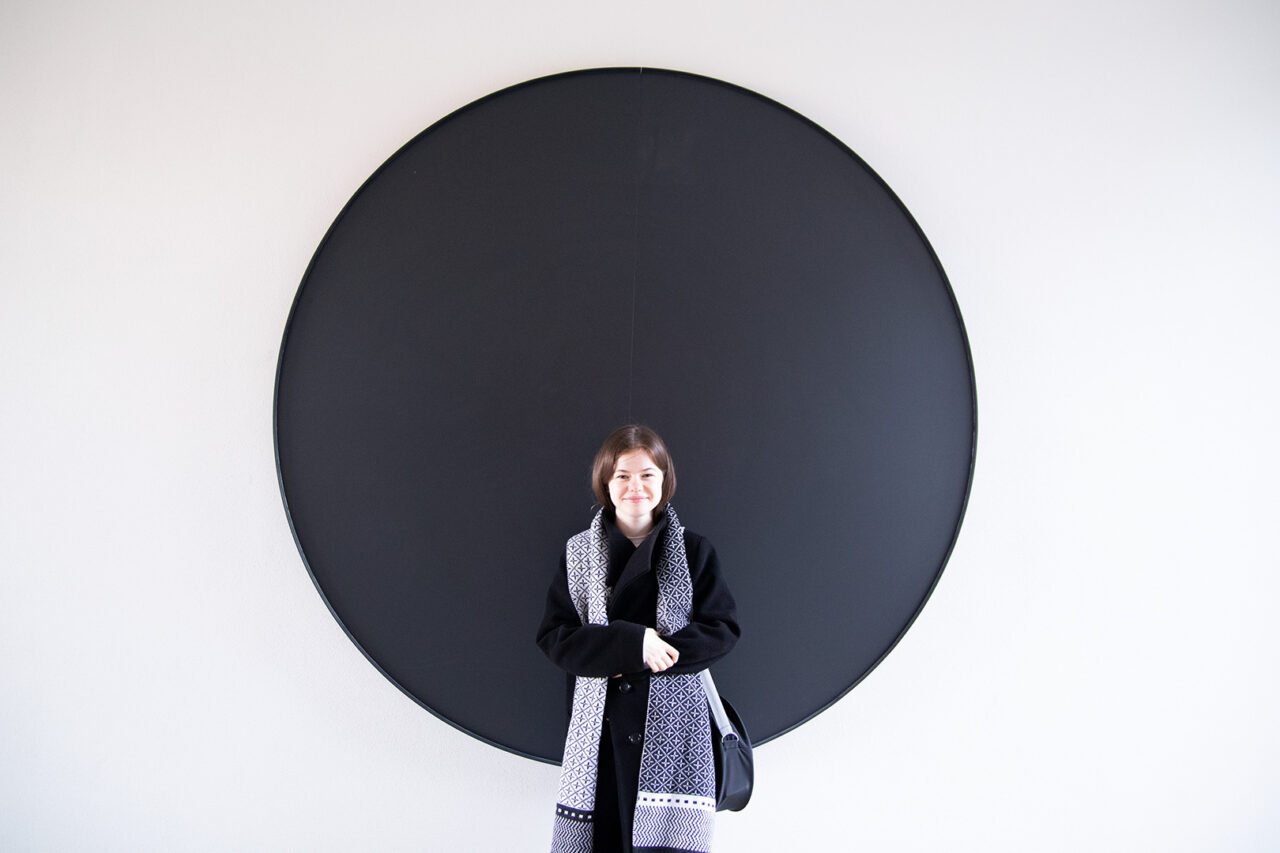
Volunteer Vika: She Gave Vinyl Records a Second Chance and Found a New Home Here in Just a Year
For an entire year, Vika Sheuka, a volunteer from Belarus, lived and worked with us. You might have seen her not only at events organized by Malý Berlín, but also helping out with various tasks like making unique bags, greeting guests, and even chatting with you during a festival or workshop. Just before she left, Vika shared what she had been doing here and what left the biggest impression on her.
She came all the way from Belarus and became so at home here in a year that she’s eager to return soon. During her 12 months in Malý Berlín, Vika made Slovak friends and might soon return to continue her studies.
Vika quickly adapted to life in Malý Berlín, and over time, we overcame the language barrier together. Visitors could see her at various events in our spaces. “It was a good experience, and the whole year was a huge adventure for me. I made new friends, experienced moments I had never had before; it was something completely new. None of this would have happened if I stayed home,” says Viktoria.
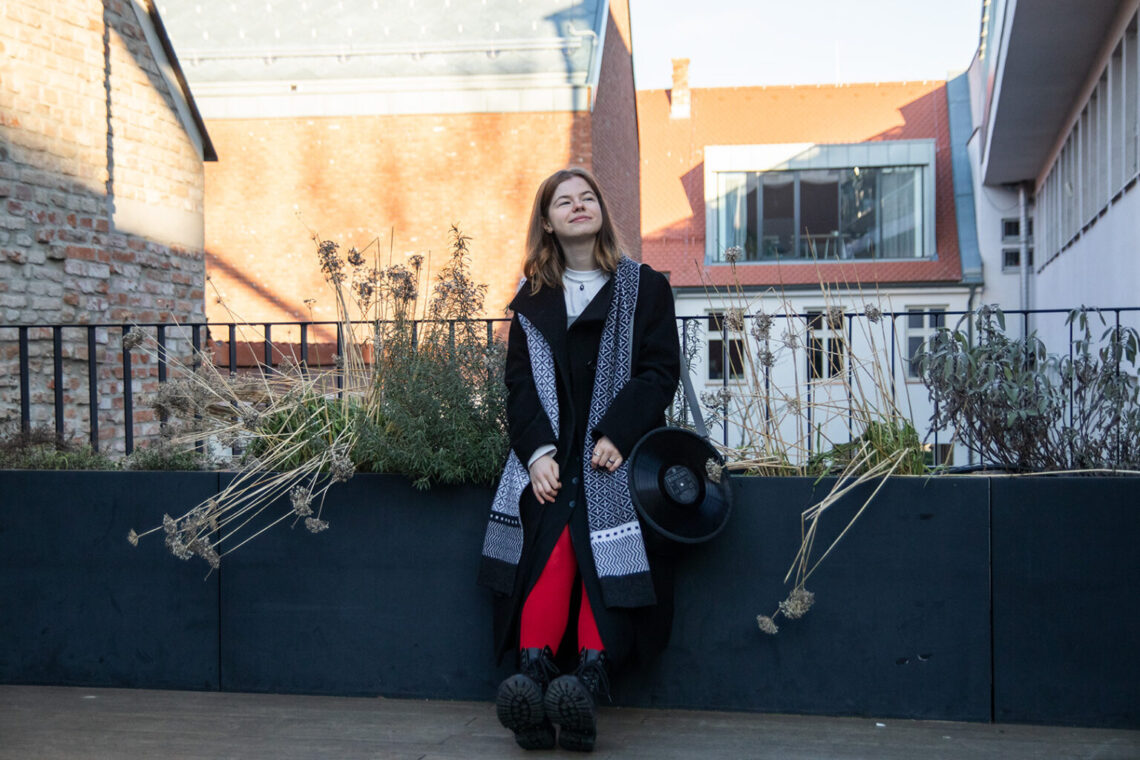
The Belarusian resident spent almost every working day with the Malý Berlín team. She became well-known in places like the nearby Kubik, a place where we pick up posters, and even made friends with the attendees of our events. “I helped with tickets, prepared decorations for different events, took photos at various events, created stories for social media, and I also helped with organizing the Emília Rigová exhibition, the Ukrainian book library, and events for Ukrainians,” explains Vika.
Besides her various contributions, Vika also engaged in educational activities. She brought an interesting workshop to Trnava. Her creative project involved making beautiful bags from unwanted vinyl records, giving them a second life – something she had already started back in her native Belarus. “I initially found the idea online. When I came to Malý Berlín, I saw there was a sewing machine here, so I decided to continue making bags in Slovakia. I even taught a few people how to do it during a workshop,” our volunteer reveals. Those who visited our literary festival, Ypsalon, surely noticed the imaginative decorations made of leaves from old books, which Vika creatively arranged throughout Malý Berlín.
Vika fully enjoyed the atmosphere of Malý Berlín, especially since she lived right in the Nádvorie complex. Not only did she not have to travel far, but she also enjoyed summer events held outdoors. “I had them right under my window!” laughs the Belarusian volunteer.
For Viktoria, it was a new experience filled with encounters with people from other countries – some she met at work, others in her apartment. “Various artists, visitors, and other residents regularly came here. They lived with me in the apartment, and there were quite a few of them since most stayed in Slovakia for only three months, while I stayed for 12.”
She enjoyed meeting people from other countries, but what about meeting Slovaks? “I see a similarity between Belarusians and Slovaks in that we have somewhat similar histories; in some ways, we are alike. On the other hand, many times I was surprised; it felt like I was in a different world.” Despite the differences, Vika would like to connect her future with our country. “I definitely want to return to Slovakia. I’ve learned a bit of Slovak here – after all, we’re doing this interview in Slovak,” she adds with a laugh.
How did she find learning Slovak? “It’s not that hard; many words are similar, but on the other hand, some sound the same but mean something different. I still have a lot to learn; my Slovak is far from perfect,” says the future student of one of Trnava’s universities, perhaps.
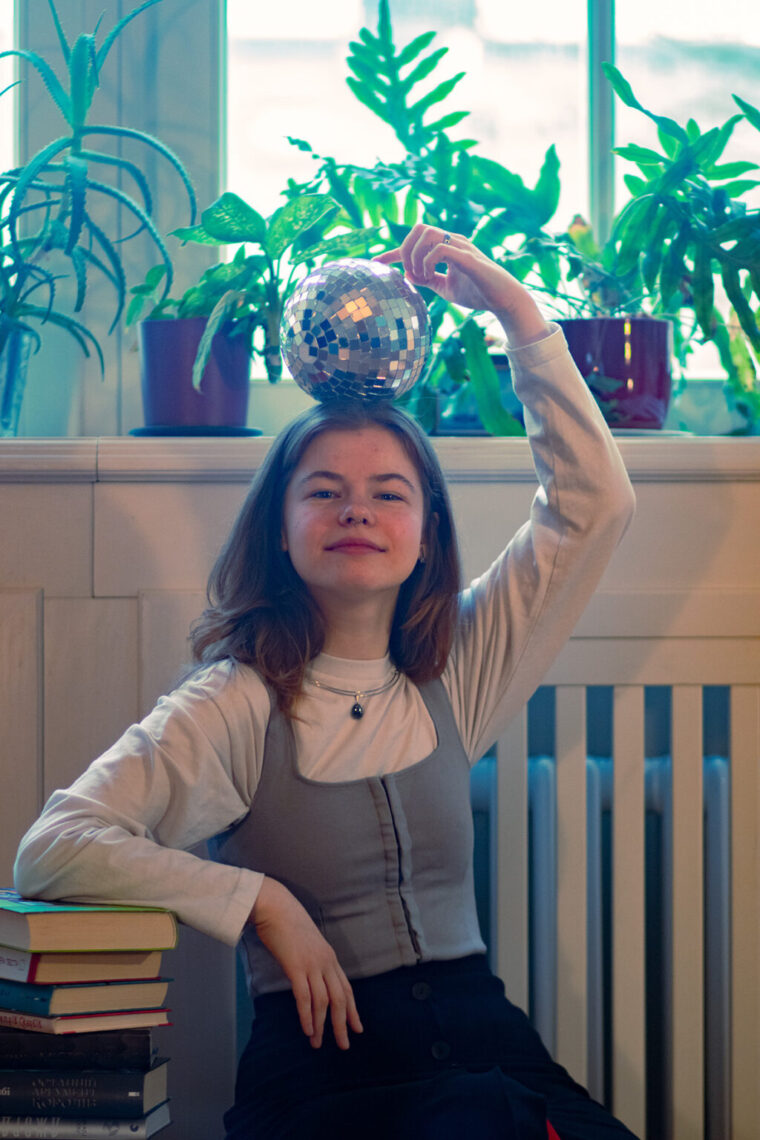
Vika adds that she would like to explore Slovakia even more – although she saw quite a bit during her first stay with us. Besides Trnava, she was impressed by the Tatras, Banská Bystrica, and other parts of our country. “I was in Nové Zámky, for example, and was surprised by how beautiful the gallery there is. But many places in Slovakia caught me off guard like that. In many villages here, you can find beautiful churches, interesting historical sites, and various attractions for tourists,” describes Vika.
If Vika returns in the fall, you might see her around Malý Berlín again – whether as a visitor, a volunteer, or perhaps as a workshop instructor. Time will tell.
Ján Janočko
Photo: Petra K. Adamková

Cultural nomad Maria Kardash talks about her impressions of the dance-research residency in Malý Berlín
Another resident who stayed in Malý Berlín and worked here on her research is the Ukrainian Maria Kardash. In the interview, the interdisciplinary artist and dance anthropologist talks about her experience working in Little Berlin, about the fact that it was not the first time she had worked with our cultural centre, and also about what made her a nomad.
Maria, is it true that this is not your first experience with Malý Berlín? When were you in contact with our cultural centre in the past?
It’s actually a story of luck, coincidence and friendship-induced networking. Malý Berlín invited a good friend of mine, also a Ukrainian dance researcher, Mariia Bakalo, to participate in a panel discussion on dance under totalitarian regimes in Bratislava in May this year. But at that time Mariia would have been on her studies in the USA, so she suggested reaching out to some of her Ukrainian colleagues, including me. And then one day I got an invitation from Malý Berlín to represent Ukraine on this panel discussion instead of Mariia. And then in May I went to Bratislava to talk about dance. But somewhere in between these two points in time, I’ve also discovered that Malý Berlín hosts a longer summer residence for artists and researchers and decided to apply for that separately. And then, as you know, it was some kind of luck again: my project wasn’t selected first, another researcher arrived at this residence but only stayed for a month, and then I was invited to Malý Berlín again.
I know that you come from Ukraine, but you don’t live there anymore. Can you tell us more about your work?
Addressing the first part of your question: unlike for many of my compatriots who were forced into the nomadic life after the full-scale war began in 2022, mine was a deliberate choice. Already since 2011 I occasionally stayed abroad for long-term work or volunteering, but then in 2018 I was able to study Dance Anthropology via Erasmus Mundus – this type of master’s programme where you spend each new semester in a different country – and my life has never been the same ever since. After graduating, I came back to Ukraine for a half a year but then went abroad again – first with the ESC (European Solidarity Corps) long-term volunteering (literally jumping on a last train as I turned 29 and these kinds of projects are for people in their 18-30s), then on an artistic residency, then with a research fellowship, then with another research fellowship and so on, until this path brought me to Trnava.
I work at the intersection of arts and academia: as a performer, I dance and take part in theatrical projects, and as an anthropologist, I research the cultural context in which the dance takes place. Lately I’m much more focused on research than on performing, and exploring topics far beyond the realm of performing arts. I study how different communities engage in the process of othering and make the division into Us and Others, how the ideas about the ‘civilisational’ East/West divide arise, how we as Westerners define what is ‘exotic’. Even though these themes are quite broad, they also come out of my dance practice, or, to be precise, from my observations of how non-western dance forms are perceived in a Western context.
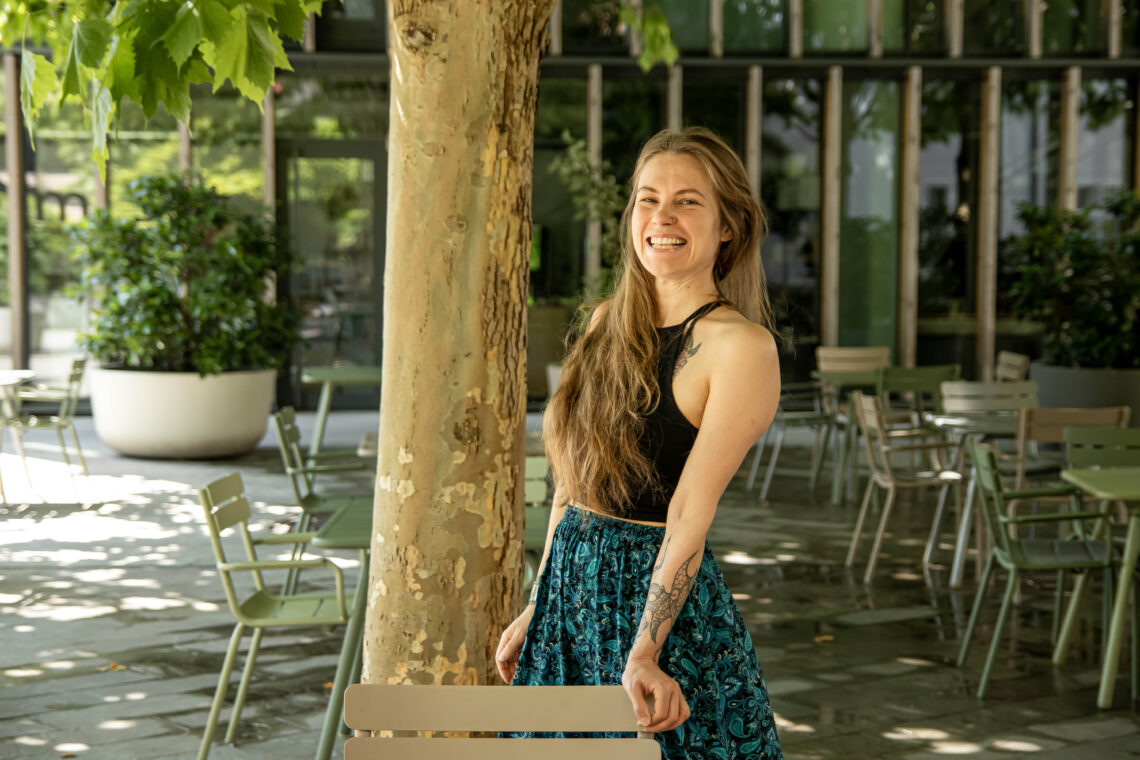
In your work, you also examine the politics of the body and dance in the USSR, with a focus on Ukraine. What makes this topic so interesting to you?
The USSR Dance Politics is one of my long-term research projects. The thing is, dance is usually considered to be less politically ‘charged’ than other forms of art. Very often it is perceived as pure entertainment, something that people do or watch for fun. In fact, like any form of art or social activity, dance can become a vehicle for cultural propaganda. I study in which way the state-supported Soviet dance ensembles operated, what kind of images they produced and how they were perceived when they toured abroad. Let’s say that this research is my humble input in deconstructing the machine of Soviet-Russian propaganda.
Besides that, any kind of dance reflects a particular socio-historical context from which it has emerged and can tell a lot about the society that performs this dance. Studying how people moved in the USSR (I would even say, how they were allowed to move) helps to understand the present-day Ukrainian context better: how my generation moves, what movements we have inherited from our parents and grandparents, and how we actually feel in our bodies.
What convinced you to come to Trnava for the residency?
I had a good experience with Malý Berlín in Bratislava, so I was really happy when I got an invitation to come back, now for a longer period. I had already made some arrangements for the summer though, so I travel around quite a lot, but I still enjoy the moments that I spend here.
As I said before, I am a nomad – I never miss a chance to go on a project in a new country. Slovakia will be the ninth country I have stayed for at least two months in (before it was Turkey, Cyprus, Norway, France, UK, Poland, Hungary and Austria). And I do believe in the power of networking – for me, it’s of great importance to connect with professionals from the cultural field and to engage in some local projects (like when Maly Berlin suggested I moderate a discussion on dance performance at The Teen Theatre Fest in Trnava). It’s about making a difference, bringing some change to the local community, but also changing and evolving myself as a person. Here I have plenty of time to work on my own stuff, but I also learn a lot from the space itself. I´ve said before that I’m much more engaged in research now than in performing, right? I don’t know, maybe it’s the atmosphere of this place, but here I often feel the urge to create. I’m going out for an evening walk, and then I find myself dancing somewhere on a bridge. If I ever produce a video result of these walks, I will call it “Actually, I was supposed to write an article but here I am dancing in random places in Trnava”.
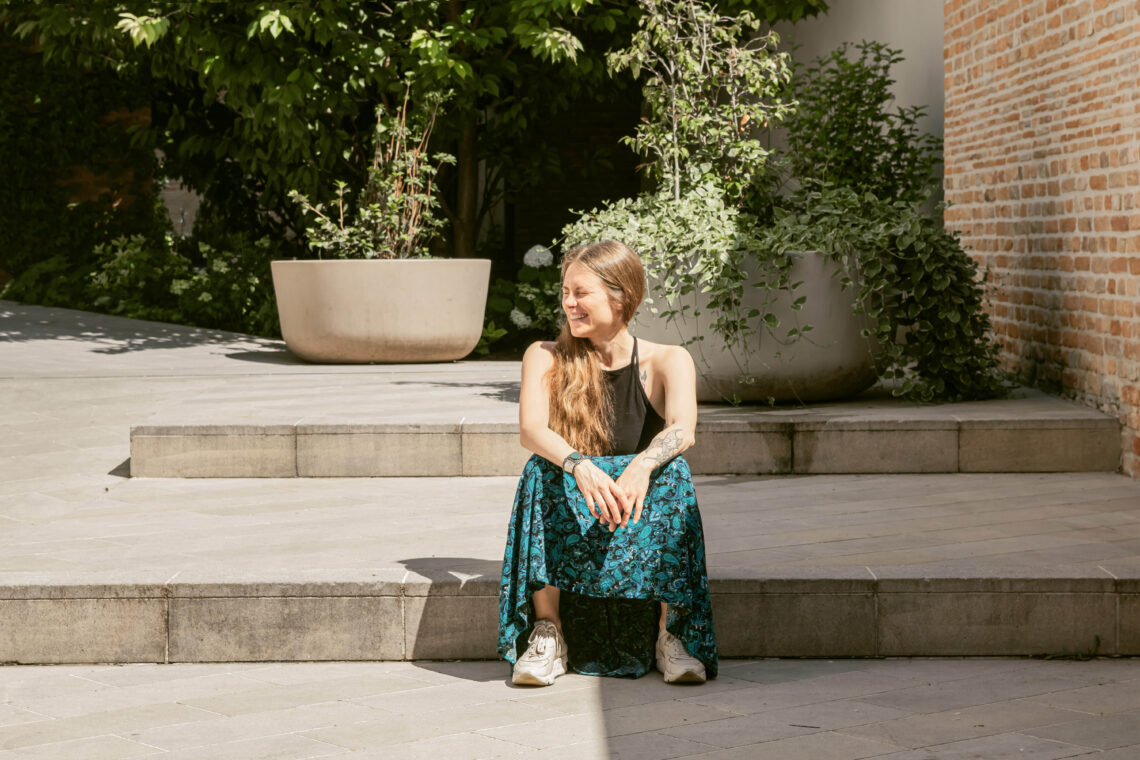
How do you like Trnava and Malý Berlín so far?
I joke a lot that Trnava is a calm and lovely town in Slovakia, but apparently everything that happens in Trnava, happens right under my flat. Living right at Nádvorie in the summer is not for introverts, for sure. There is something happening every week if not every day: a concert, a festival, an exhibition. So, my advice for future summer residents: prepare to be sooooo engaged in the cultural life of Trnava! Eventually, you will find joy in it even if you are an introvert: watching a world-class jazz concert from the terrace of your apartmentwith a glass of wine is quite a unique experience (and then the world-level jazz musicians try to steal your chair from this terrace – also a unique experience and definitely a funny story to remember). I know I might sound sarcastic, but I actually enjoy having so many activities during this residence as a bonus to the main ‘package’. I would even say it’s a privilege.
Please reveal what exactly you are working on in Trnava.
Even though I applied for a project on Soviet dance, I’m working on something different right now. In fact, the way the panel in Bratislava unfolded has pretty much determined the topic of the article I decided to write for Malý Berlín. During that discussion in May, I began to wonder why under the declared topic of ‘Dance under Totalitarianism and After’ we were discussing only the high-art-western-canon kind of dances – ballet derivatives loosely labeled as ‘modern’ or ‘contemporary’ dance (why loosely – because I’d say that all the dances practiced in the present moment reflect this present moment and therefore are ‘contemporary’). As an anthropologist, and no less as a person exposed to non-western cultures through work and personal communication, I have a much broader understanding of what dance is and what kind of dance deserves to be studied and discussed in panel discussions. Surprise – all kinds of dance! I would even say all kinds of human movement – for example, with fellow dance researchers in Ukraine we have been talking about new kinds of social choreographies (collectively repeated movement patterns) that emerged with the start of the full-scale invasion, like massively going to the shelters during air alarms. So that’s what my article will be about: where and how we draw the line between dance/movement that falls into the category of art and dance/movement that is missing some qualities to be considered art’ from the westerner’s point of view.
Ján Janočko
Photo: Lívia Martvoňová
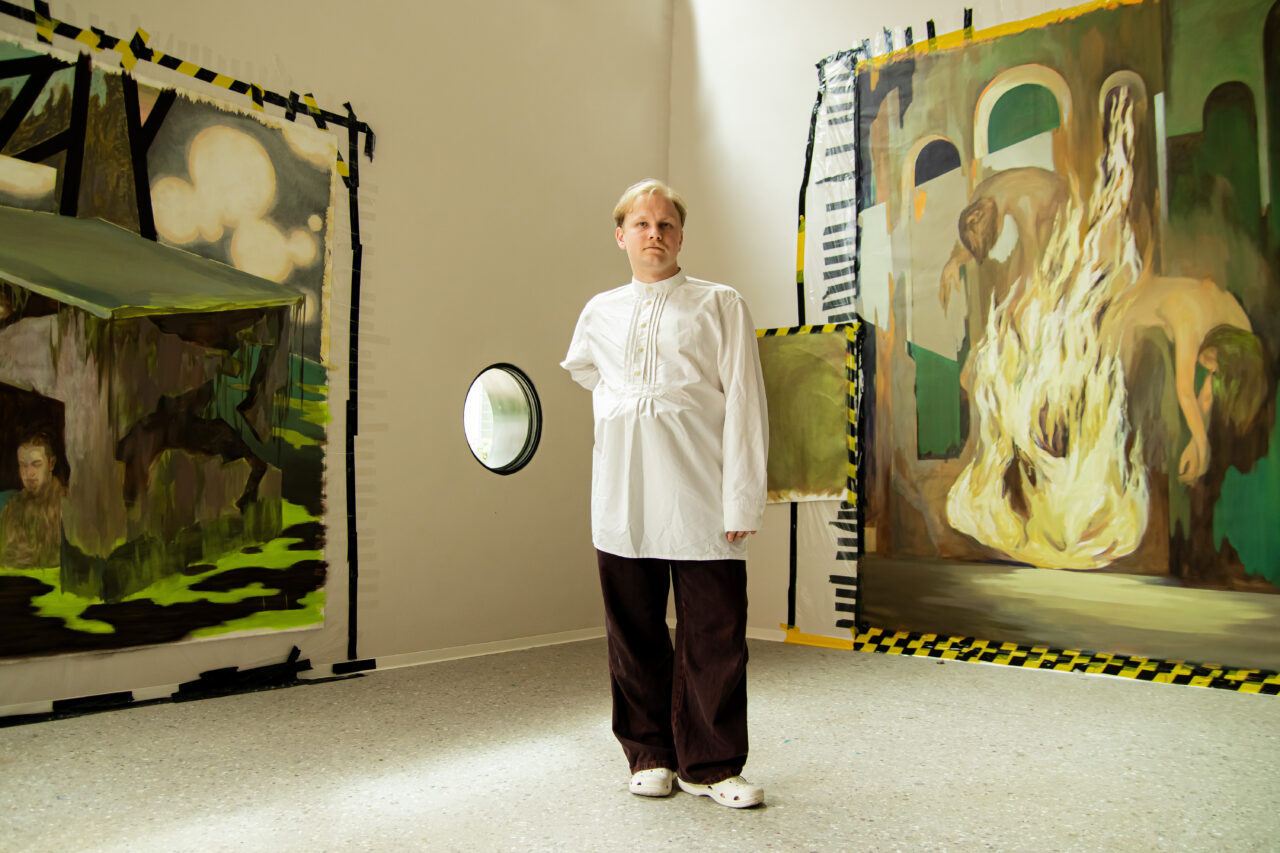
The art studio in Nádvorie has its first resident: What did Belarusian Serafím work on?
The cultural center has been organizing residencies for skilled artists from abroad for a long time. The most recent space was given to the Belarusian painter Serafím, who also got the opportunity to be the first tenant in the studio at Nádvorie. You will soon be able to meet him in person. He talks more about the event at which he will invite you to the studio and about his stay in Slovakia in this interview.
Seraphim, you are the first person ever to work in the studio at Nádvorie. How does it feel to be part of such a premiere?
I’m really proud that I’m the first resident here! Now I’m working in excellent conditions. But here it was unusual for me to start in a clean new space, because usually art studios are dirty, there is a mess everywhere etc. and these are the conditions that I was used to. Sorry, I don’t mean to say something bad, it is a good studio, it is something new for me and I really like it!
So how did you get used to this space?
Oh, it is a very good experience, because I have never been to such a long art residency, as well as abroad. And I really enjoy creating my art. The art studio here is bigger than mine in Minsk and I have a great opportunity to work in such a big space and paint very big artworks that I have not painted yet. All the stuff I needed was here and I started very quickly and also got used to it very quickly.
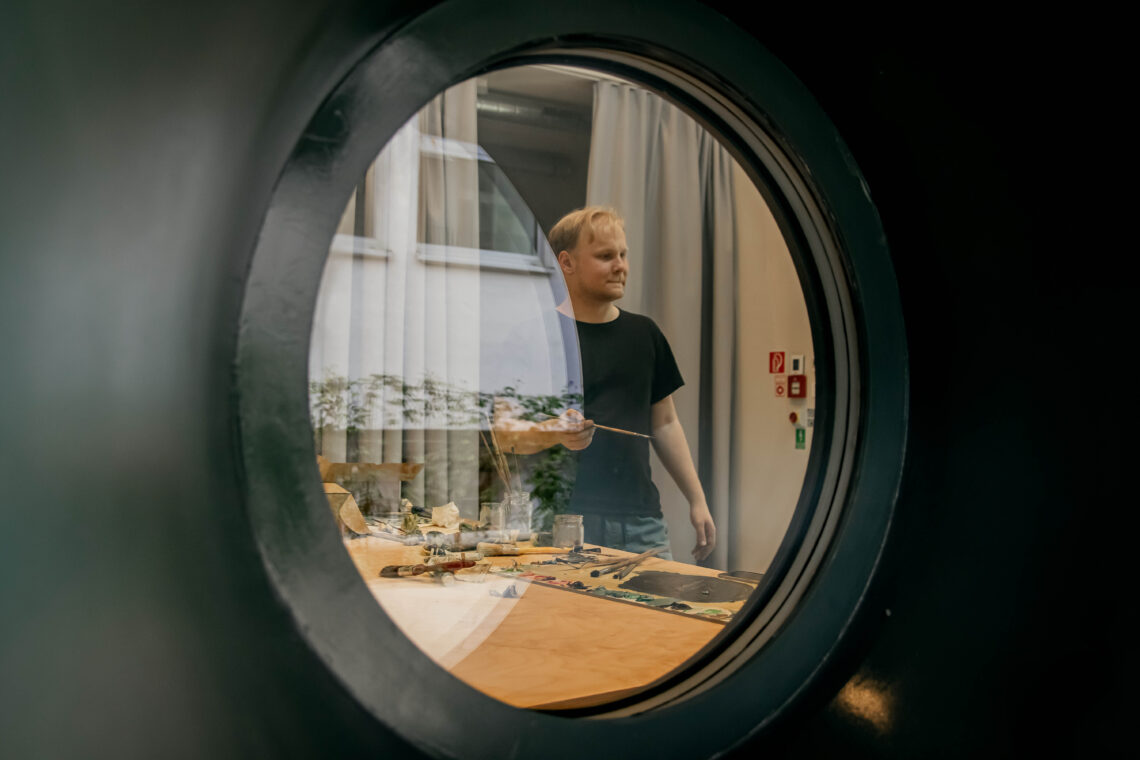
Can you tell us more about what you do in the studio, what you are working on?
Well, I’m actually a contemporary artist and painter. I usually work on big artworks and do a series in which I reflect on the topics I’m interested in. Now I’m working on the theme of loneliness and emptiness in which I’m reflecting on my social life and a little bit of the political situation in my region. First I started to work on some sketches in Minsk and arrived with some ideas and also I’ve done some sketches here. Then I started to paint my sketches on three big canvases and I will show them in the Open art studio.
If I’m not mistaken, you also found new friends at Nádvorie. How do you like this kind of socializing?
Yes, I met a lot of people in Malý Berlín and Kubik. Now I spend most of my time with people from Kubik because they are very close to me. Some weeks ago they invited me to a concert that they did and now I usually spend time with them.
We go for a coffee and smoke and I have a lot of interesting conversations. I can say that they are very kind and cute guys. But also I talk a lot with my coordinator Soňa and Lívia from Malý Berlín but unfortunately they are very busy. It’s cool that I also have conversations with Lívia in Polish to practice, because I’m learning it now.
Soon we will have an Open studio event here, where anyone who is interested in seeing your work will be able to meet you. Will it be a departure from your comfort zone?
It is an interesting question because I am always in the middle between being an introvert and being an extrovert. But also this is not my first experience in doing these events and I am always ready to have a lot of conversations with different people. But what I’m definitely awaiting is a quick coming and then quick leaving of positive emotions. This can happen even when an event is still going on.
Are you looking forward to this event?
I like the openings of exhibitions. Here I can meet a lot of interesting people. It is an artistic tradition and it’s very interesting for me to do it elsewhere that in Belarus or another country, I mean Poland and Lithuania, where the exhibitions are mostly attended by Belarusians or even only by them. Of course I’m looking forward to this experience!
Will you be preparing for this event in any special way?
Hmm, here I can say that all of this preparation is usual – music, wine, well hung paintings etc. It is the people who make this party really interesting and attractive, just people.
Tell me, how did you get here, to the residency organized by Malý Berlin?
My friend just sent me a link and I applied. But what I want to say is, that I was not expected this veeeeery huge amount of a different activities, concerts, events, etc. I admire it a lot! And also I want to thank you that there are still a lot of opportunities for Belarusians – I am really happy about it.
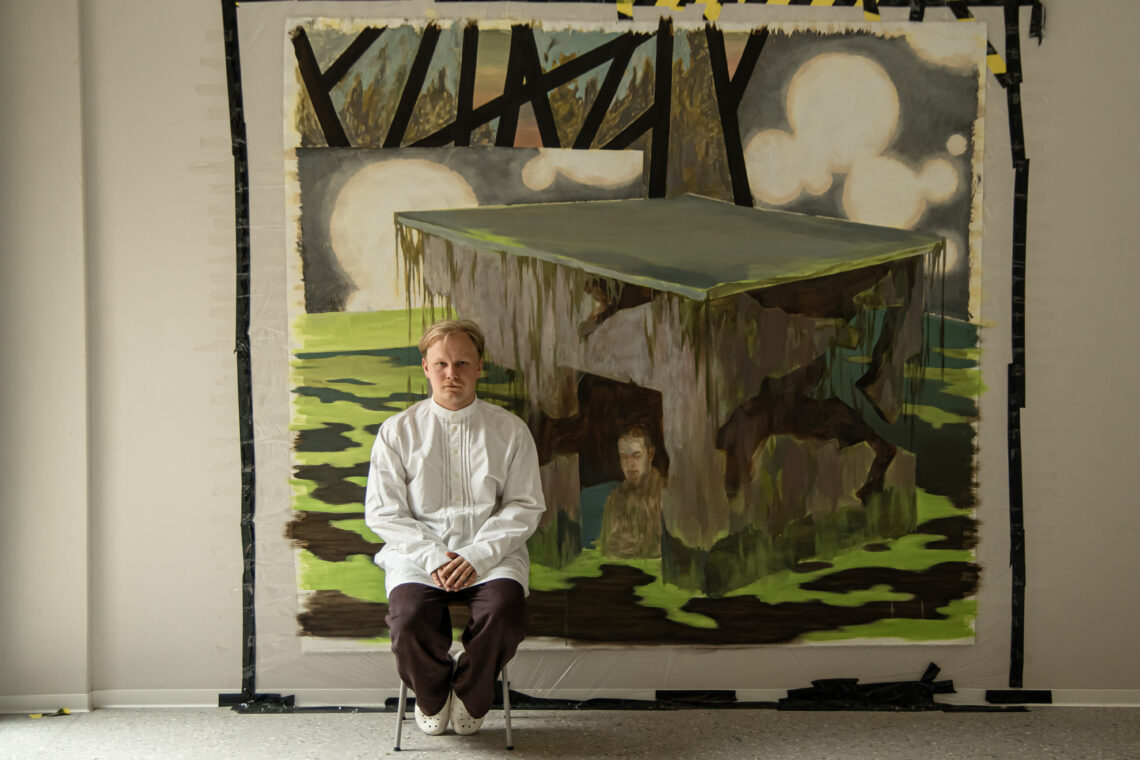
What did the two months spent in Trnava bring you?
Before this art residency I had never been abroad more than for a week. I feel a bit like an emigrant and feel everything that emigrant feels – language barrier, culture differences, climate differences… Some of these experiences are tragic and some are funny but it allows me to fully feel life and what is important for me is to fully concentrate on my artwork.
What was the purpose of your residency? Were you able to fulfill it?
The purpose was to paint some new works – now I’m at the end of fulfilling them and to make some experiments in my working process – that I’m not sure that I can fulfill. But the most interesting thing for me is to look for new acquaintances, wherever I go. It is not the most important purpose, usually it is the default purpose but when it happens a lot of energy comes to me and helps me also in my work.
In the past, Serafím was a student of graphic design, later he decided to be an independent artist. When he was 17 years old, he held his first exhibition at home. He studied at the Belarusian Academy of Arts. He came to Trnava for a two-month residency, during which he creates in a studio in the Nádvoria complex.
Ján Janočko Photo: Lívia Martvoňová
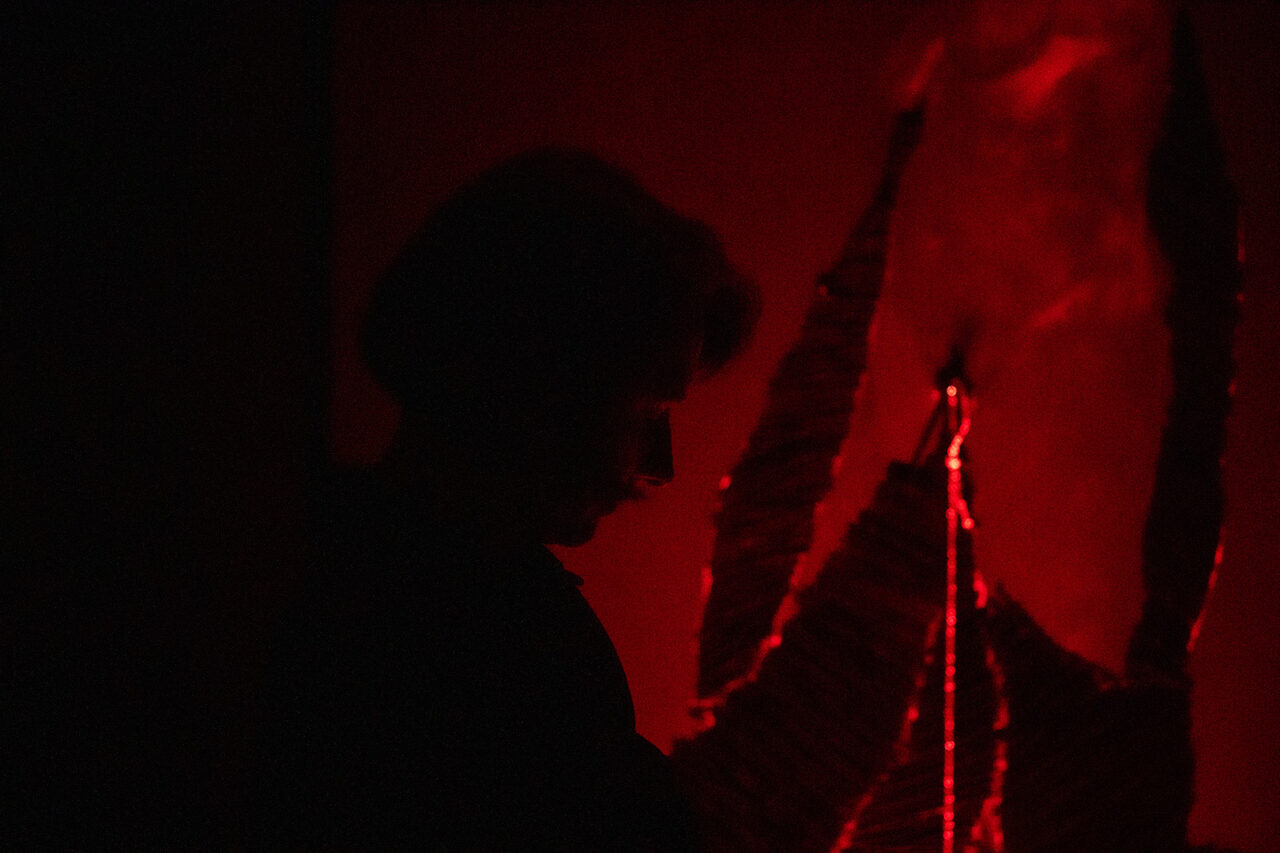
For a three months, Hanna Palei from Belarus was a part of Malý Berlín. Read about what she worked on during her time here
Few days ago we said goodbye to another resident on Malý Berlín. This time it was Hanna – cultural manager from Belarus. We talked with her about her work, last exhibition at Čepan Gallery and also about her plans after the residency.
I usually ask people about their projects and how they liked their residence. But first of all, I want to ask You – what will You miss the most, when You leave?
The opportunity to work freely, calmly in a supportive atmosphere on my project.
What did You miss the most from Belarus here, during your days in Trnava?
I would say that I generally miss and experience great pain, tragedy and loss from the loss of my project, which I have been developing for the last 4 years in Belarus since 2018. This is an independent cultural space pershykrok.by which united many art enthusiasts from the regions of Belarus and helped implement cultural and art projects. It has been a space for discussion, for lectures and for independent art projects, and in recent years a space of support for the local community.
The exhibition in Čepan Gallery is still actual now. Can You describe more about your work with artist Emília Rigová? What did You do for “zredukovaná”?
This is a very symbolic work for me. My acquaintance with the contemporary art scene in Slovakia started with visiting the exhibition Untitled, which Emilia presented at the Synagogue in Trnava. Then I was amazed at the ways the artist works with the theme of Roma culture in Slovak society. And it so happened that my last week in Slovakia we jointly opened the exhibition “zredukovaná”.
At the exhibition I act as a curator and author of texts. During the residency, I studied a lot of the artist’s practices, her work with memory, with the theme of the Holocaust Roma. Working with memory has a special personal meaning for me, because in my country history is being rewritten right now and what was historically true for another three years becomes prohibited. People are recognized as enemies for having a different political view.
Therefore, I have deep respect for the topic of historical memory and rethinking and the work that Emilia has been doing in her artistic practice for many years. After all, without understanding and forgetting the past, it is impossible to move into a better future.
How did You like this experience – I am talking about work with Emília but also the topic of exhibition.
Firstly, I was lucky, thanks to Emilia, to become part of the performance as a viewer. And it’s a really impressive and important experience for a curator to be part of the process.
Secondly, but more important for me, was the topic that I encountered in the process of observation and preparation for the text. It seems to me that this state of the borderland, which I caught, and this is my personal state now. Now I have a feeling of uncertainty and borderline and I wonder where I am now, who I am in a new space and country. Such a process of searching for identity.
Working on this exhibition was not the only thing you did in Malý Berlín. Can You please tell more about your work here?
While working in Maly Berlin I had the opportunity to work on the development of my project. Now with my team I am developing a CultTech startup in the field of education maramora.co – a platform for the education of people not involved in art, with online courses, guides and texts for everyone who is interested in art as a means of overcoming trauma and crisis situations.
Thanks to the self-directed residency, I had the opportunity to choose the most relevant program for my professional development right now: work actively on a fundraising company for the project, as well as develop partnerships with cultural institutions in Slovakia. For example, together with the maramora team and Maly Berlin we have prepared a guide to Slovak independent art spaces for international collaborations:
https://www.maramora.co/media/independent-art-spaces-for-international-collaborations-in-slovakia
And I hope for further partnership with Malý Berlín.
What were the main differences in working in the cultural sphere in your home country and now, in Slovakia?
The opportunity for professional development and the opportunity to work at all and continue my practice is a great joy for me and I would say a privilege right now compared to Belarus. While working in Maly Berlin, I also noted the supportive atmosphere and comfortable conditions and opportunities for professional growth for me as a cultural manager and curator.
What did you find the most interesting during your residence? I am asking about Malý Berlín but also about life in Trnava and Slovakia.
This is my second time visiting Slovakia and for the second time I am surprised that any small town has an independent cultural space, gallery and active cultural life. This is a big revelation and a pleasant surprise for me.
During my visit to Slovakia, I was able to visit Zilina, Pestany, Banska Bystrica, Trnava and Bratislava, Novy Zamky and I met very pleasant and inspiring practices and places that are also open to international collaboration and ready to cooperate. For me, this is the most interesting thing I observed.
Profile:
Hanna Palei (b.1987) is Belarusian cultural manager and curator. She studied European Cultural Foundation program (art management). Her curated projects are about local identity, feminism and living ordinary life in Belarusian context. She is the founder of cultural and educational space in Belarus (pershykrok.by), established in 2018 as a local art actors network for studies and practice of new media. Among her curatorial projects: International festival “Month of Photography” (regional program, theme: Survival, 2020), Series of audio-visual female portraits “Authentic” (2021), Educational art program “Palesse in Focus” (2022).
Photo: Petra K. Adamková

Michal and Guro recorded an album with us – read about the Slovakian-Norwegian residency
This summer, music and horror-like screams could be heard from the main hall of Malý Berlín. Don’t worry, there was no drama, it was just our residents who decided to record new songs for their EP here. We talked about (sometimes really dark!) music with (our old friend and) musician Michal Jahoda and his residency guest, Norwegian singer Guro Kverndokk.
You may have already caught Michal Jahoda’s name in connection with Malý Berlín. A year and a half ago, he spent a few months on a residency here, during which he recorded songs for his previous musical project. After a long break, he returned, with his finished Black Hole Constellation project (part of which he recorded here), and he brought reinforcements to a familiar environment. “I am collaborating with the Norwegian singer Guro Kverndokk on a new EP and I am glad that we can work on its creation in this space,” says Michal Jahoda.

Who is this colleague of his at the residency? “In the past, Guro recorded experimental vocals for The Outsiders Saga II as a guest in a studio in Bergen. Due to the very good cooperation, mutual openness to go to the limit of musical abilities and the desire to experiment even in the most uncharted musical waters, we agreed that it would be interesting to make a joint EP.”
For Guro, it was the first experience not only with Malý Berlín, but also with Slovakia. “My experiences with the place and the people are very positive. I had never been here before and to be honest I knew very little about this place. That’s why I didn’t know what to expect,” admits the Norwegian singer.
The pair set up a studio in our main hall. “The space is large with lots of windows, so it’s possible to get air and daylight from the outside if needed. If you need to create your own scene and atmosphere, curtains and other acoustic elements can be used to completely block out light and noise,” explains Guro. In the course of five days during their stay in Malý Berlín, they recorded vocals, choirs, various voice experiments and also arranged parts of new songs. On the last day, they performed for us, the people from Malý Berlín, a small concert with a short demonstration of the creation process.
“We mostly used the time to find our sound, connect elements and build the skeleton of the album. We will now work on it separately in our home countries and hope to meet again at the end of autumn,” Guro hints at their plans. The singer, who also recorded terrifying screams in Malý Berlín that should be used on the album, was quite happy here, never feeling alone in a foreign country. “I consider Malý Berlín to be a very open and inspiring space to work. It can be a lonely experience when you go to work in another country alone, but thanks to the close contact with the people working in Malý Berlín, I didn’t feel lonely at all. The first day I was shown around town and we all went for a glass of wine. I always had someone to ask about everything I needed,” says Guro.
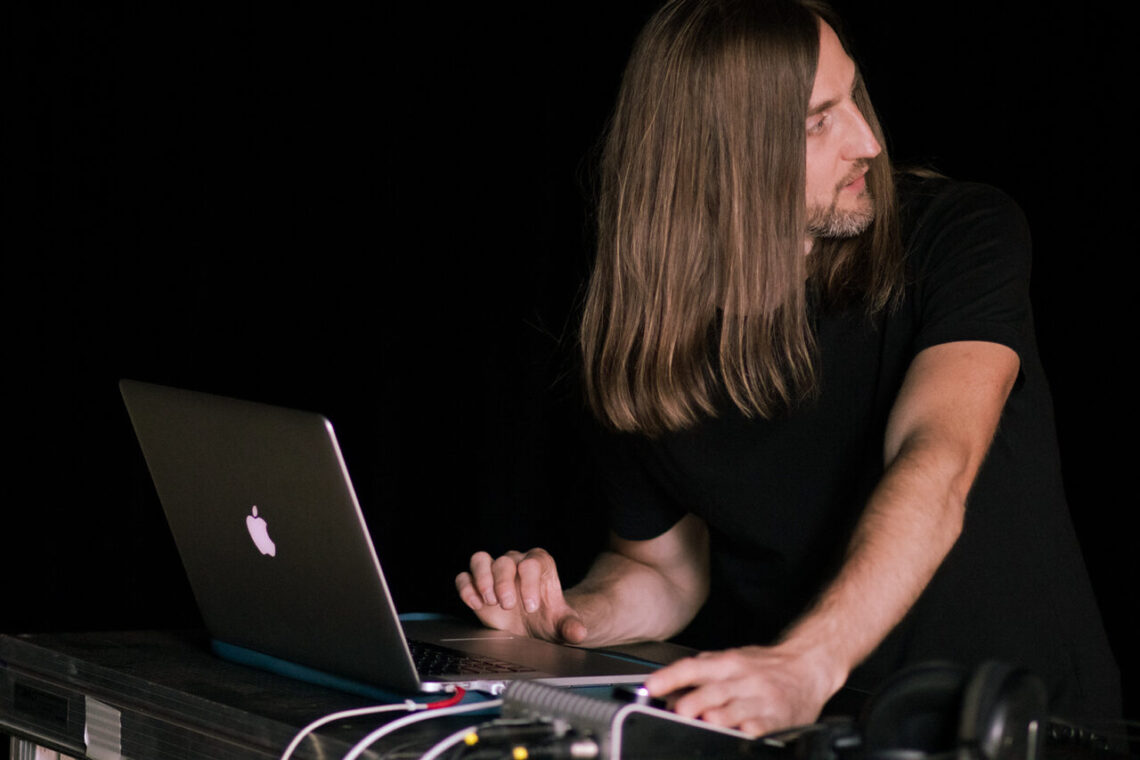
Making an album is a long process. When could we hear the results of the work of Michal and Guro? “If I were an optimist, and we would get the necessary resources and opportunities to devote ourselves to it 100%, I believe that it would be possible to hear it in a few months. Despite the fact that we have a vision and experience, such a creation will require more time, as we want to come up with something we have not heard yet,” explains Michal Jahoda.
Michal, who came up with the idea for the residency in Malý Berlín, had already been to our cultural center in the past. He spent three and a half months here working on his compositions, and when asked if we will ever see him here again, he answered positively. “This place and the people here are still in my heart. So I believe that there will be an opportunity to come back here again.” In a similar spirit, his musical colleague Guro expressed herself at the end of the residency: “I think what surprised me the most was how well everything was organized. Easily accessible resources and a sense of community. I’ve done a lot of coordination work myself and I know how difficult it can be. I am very impressed!“
Photo: Petra K. Adamková

Cavid from Azerbaijan was in Malý Berlín for three months: What did he work on and what attracted him to Trnava?
In the first half of this year, we had a resident in Malý Berlín from Azerbaijan. Cavid was working on a new book and exploring Slovakia. What did he like most about us, what did he learn and what did he take from us?
First of all, I want to know more about your background. Tell me more about your work in Baku and also maybe a story about your university degrees.
I was born on 7 May 1993 in a student dormitory in Baku. Because, my parents were students at the time. I started from Russian-speaking kindergarten and school. But quickly switched to Azerbaijani and English/Turkish language high schools. Such is life in Azerbaijan, we grow up with at least 4 languages! Later I graduated from school in 2010 and went to university in Turkey at the age of 17. Studied Computer Science for a year, then dropped it. Studied Latin Language for a year and dropped that one too. My third study was English language and literature, but it was boring – because I already knew most of it. So I dropped it too. At first I felt that I lost my 10 years of just partying, hanging out and playing games. But truth to be told, these professions weren’t really my jam. So I became a journalist! I have been working as a journalist for over a year now.
But alongside it, I am a member of VarYox, an art collective. In my country, getting involved in art and staying neutral is too hard. Since the government essentially controls the art sector through the Ministry of Culture, we had to improvise and register as a company, instead of an NGO or non-profit organization (requirements are just too harsh). It hindered our efforts to get grants, but at least we managed to organize concerts, festivals, exhibitions and art residencies throughout our 5 years of existence. It was through TEH Easthub – a network VarYox is a member of – I arrived at Trnava.
What was the first “poke” to go abroad? And why did you choose Slovakia and Trnava?
This wasn’t my first rodeo. I travelled to France, Sweden, Hungary, Germany, Greece before, but never Slovakia. I saw a volunteership program announcement at first, published by Malý Berlín. I applied, but was told that I was overqualified (another way of saying I am getting old, lol!) So I got a 3-month residency program instead (more on this later). But for some reason, Slovakia isn’t the first choice for Azerbaijanis when they go abroad. I think the reason is Slovakia doesn’t really advertise itself in our country. I chose Trnava because I immediately grasped the privilege of living in one of the most historically important cities in Europe. I think this is a privilege that even people in Slovakia take for granted. Our countries were part of the same economic system for decades. One can especially see it in Družba – a very socialistic name and a place where you can still find socialist style murals. „Czechoslovakia“ was the brand name for quality in my part of the world back then. My father still refers to this country like this! My mom even said I should learn some Russian before coming here. But the times have changed, as well as the borders.

What exactly were your goals? Did you work on some projects?
In comparison to Baku, Trnava is a small city – which makes it less chaotic in my eyes. I wouldn’t like to live in Bruxelles, for example. So many people, always making noise and hurrying somewhere. Trnava was a place of peace for me. An ideal place to take your time to write articles and books. I have written dozens of articles already, but my biggest aim is to translate a book. I spent most of my time translating “Caucasian Albania – An International Handbook”, an upcoming book authored by Jost Gippert and Jasmine Dum -Tragut to Azerbaijani. Caucasian Albania is a modern exonym for a former state located in ancient times in the Caucasus: mostly in what is now Azerbaijan (where both of its capitals were located). We still have the Udi people, who regard themselves as descended from the inhabitants of Caucasian Albania. However, its original endonym is unknown. By the way, do not mistake it for Albania in the Balkans, they are not related to this. Unlike Albanians in the Balkans, Albanians in Caucasus spoke a Caucasian language that was written with 52 letters. It was one of only two native scripts ever developed for speakers of an indigenous Caucasian language but was lost for centuries, only to be rediscovered in 2003, in a remote Christian monastery on a mountain in Egypt.
What was the most interesting thing you experienced here?
Churches! Or, abundance of churches! As a person interested in Caucasian Albanians and their religion – Christianity, I am a frequent visitor of churches. But you have to spend at least 2 weeks to visit all the churches in Trnava. Being from a culturally secular but traditionally Muslim country, the city certainly painted a different landscape for me. I was somewhat in an alternate reality.
Have you experienced some “cultural shocks”? Did anything surprised you so much you could not believe it?
I didn’t know that Slovaks call their language “Slovensky” and their country “Slovenská republika”. Then I met some Slovaks who complained about always being mistaken for Slovenes of Slovenia. I often joked – “what did you expect when you call yourselves Slovenky?” Yes, it might not be a cultural shock, but it is one of those facts that you don’t know unless you get to learn a bit of Slovak language. But frankly speaking, there isn’t much to be surprised about. Geography was my favorite subject at school!
What did you learn here? Did you learn something you will use in your work or life after coming back to Azerbaijan?
Where do I start? I picked up Slovak a little bit. I learnt how to effectively shop for food – if I decide to come back to Europe sometime later and maybe even settle, it will be useful. I also know how to travel easily, fast and cheap – as a travel enthusiast, it will help me plan ahead my other trips and seek fine deals. I also observed how the Malý Berlín team dedicates their entire day for planning events, always trying to be on top of everything. But they also know how to have fun and don’t turn into a complete office plankton. I also used my time here to attend as many music concerts as possible – famous bands usually don’t visit Baku. But I intend to change it! Trnava was also a fine base for me to travel and meet many professors, scholars who were interested in my country and subjects IN research.
I will probably continue my translation of the book even after I return to Baku. Because 3 months aren’t enough for complete translation and proofreading of a 700+ page book! Also we know how publishing houses can be grumpy about everything. Overall, these three months were one of the best chapters in my life that I will cherish forever.
Photo: Petra K. Adamková
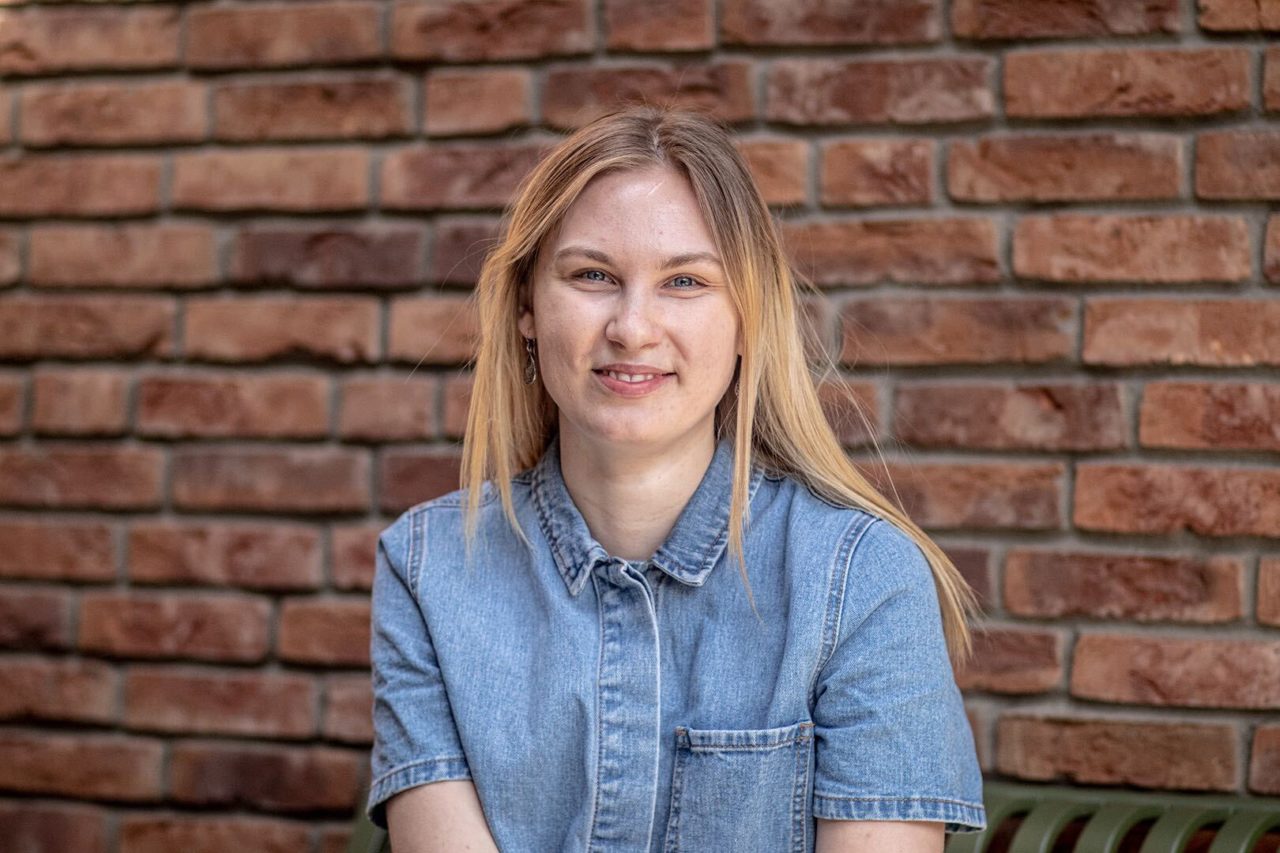
Swedish volunteer Rut spent six months with us. What interested her the most in Malý Berlín?
You could meet Rut at our events for half a year. In addition to her work, the Swedish volunteer also enjoyed many new experiences and surprises that her stay in our cultural center and Slovakia in general brought her. She reveals more in our interview.
Rut, you are were for almost half year. Can You describe this Slovak experience in one sentence?
I would say it has been an incredible experience I never thought I would experience.
And now – can you tell me more? How did you like it here?
I have really liked my stay here, and It’s been so amazing to see and live in another culture and country I never really thought of visiting before. I feel that I have met a lot of interesting people not only from Slovakia but also other volunteers from other countries which has been very interesting and fun. Also learning more about myself because I have never lived in another country this long before, I think it has been a really cool experience. Additionally, I really loved Trnava as a city, it is so nice, and I really feel a little bit at home here. I love all these beautiful churches, cafés and old buildings.
Can you compare your expectations with reality? What surprised you the most, in good or bad way?
I think the language surprised me the most in Slovakia. I have never come into contact with this kind of language before and thought it would be easy to learn, but it was a surprise to find it so different. Both good and bad, because the language sounds beautiful when people speak it, but it was really hard to learn. The people and the community also feel much more supportive than in Sweden. People in Sweden are very individualistic and do not talk to anyone unless they have to. Here I have the feeling that people help each other more in everyday life. Even though I have the feeling that people here are a bit shy towards foreigners at first sight, people here are very friendly.
Tell me more about your routine in Malý Berlín. What did you do?
My responsibilities at Maly Berlin usually include helping to take photos and posts on social media for various events, as well as helping to create posters and working around events and activities. For example, we had a Scandinavian film festival at Maly Berlin, and I was able to help select some films and participate in different ways. I also write down interviews with emerging artists and creatives. These interviews are then later published on the Maly Berlin website. During my stay, I also have several projects of my own. For example, I did a discussion with the Malý Berlín team about the Swedish author Astrid Lindgren. On the side, I am writing an article about Swedish brands, especially smaller independent design brands, and the Swedish/Scandinavian way of thinking about design.
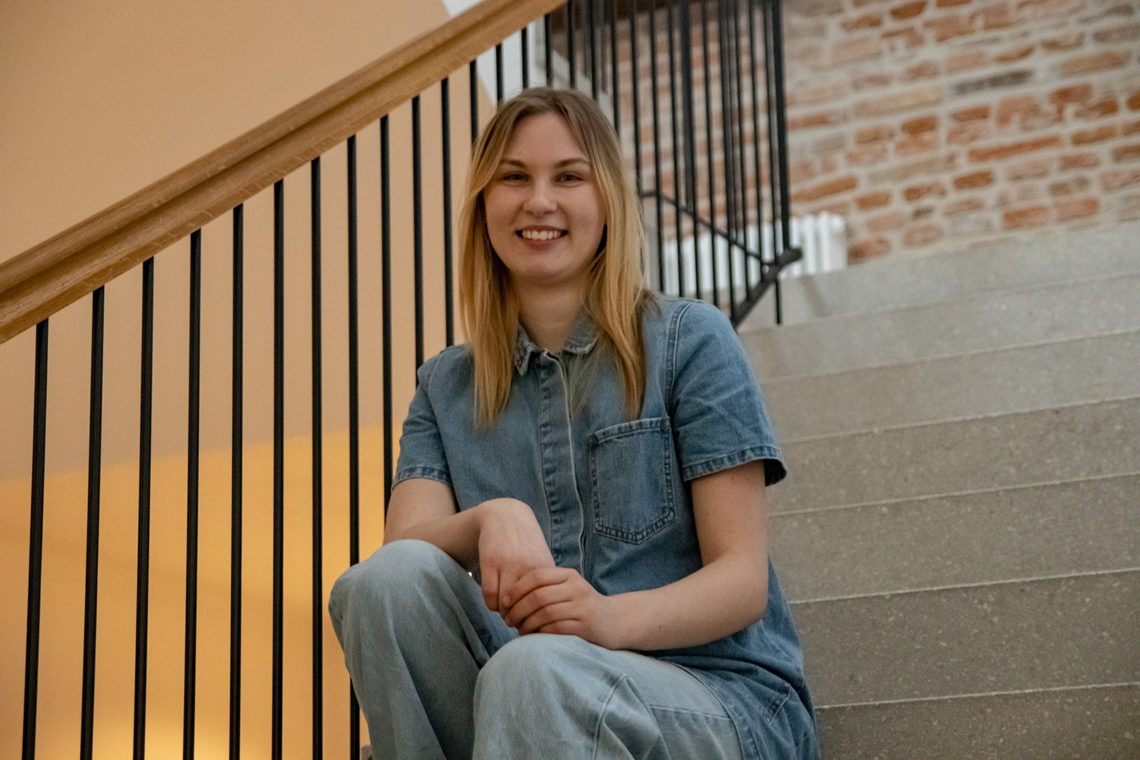
Which events did You like the most?
Because I have an interest in for example dance and music, these have been my absolute favorite events to experience in Maly Berlin. For example, there was a fantastic dance performance by the local dance school Alegria which I really liked and that just made me want to go take a dance class myself. But also all of these amazing Slovak and Ukrainian bands and artists which I found very different from Swedish artists and music, that was fascinating.
What was the most interesting experience during your residence here?
I think it must have been going to the High Tatras. Everyone was telling me it was a must-experience and that I just had to go. It was, I think, the most amazing experience. We were hiking in these incredible mountains, and I feel like I got to see the other side of Slovakia, the more eastern side, which I never visited before. I was for example taking a bath in this hot springs, which was amazing, and I didn’t even know they had this in Slovakia.
What did You learn? What have these six months in Slovakia taught You?
Well, I have learned a lot about working in a cultural space and center, and how much people appreciate visiting it. It is so incredible to work with all these different artists and see what they are so passionate about. I feel like every event or workshop I have been to was very inspiring, and it is amazing that there exists this kind of space for everyone to showcase their art or music etc. Also, I learned a lot about Slovak culture, food and language. I have tried halušky for example and even made it when I was visiting High Tatras. I feel like they have a lot of good liquor, and wine here, and also great honey and cheese.
How about the Slovak language? Did You learn some phrases, words, maybe sentences?
I really tried to learn as much Slovak as possible during my stay here, but it is a really difficult language because of differences to my own language. Swedish is much more similar to, for example, German language, so this was a totally new experience for me too. But I learn the basic phrases, for example when I go to the shop and ask for something or say „here is my card“. Of course, I can say things like goodbye and the different ways to say it, like „Čau“ or „Dovidenia“. And also „Dobrý deň“ and more different greeting phrases.
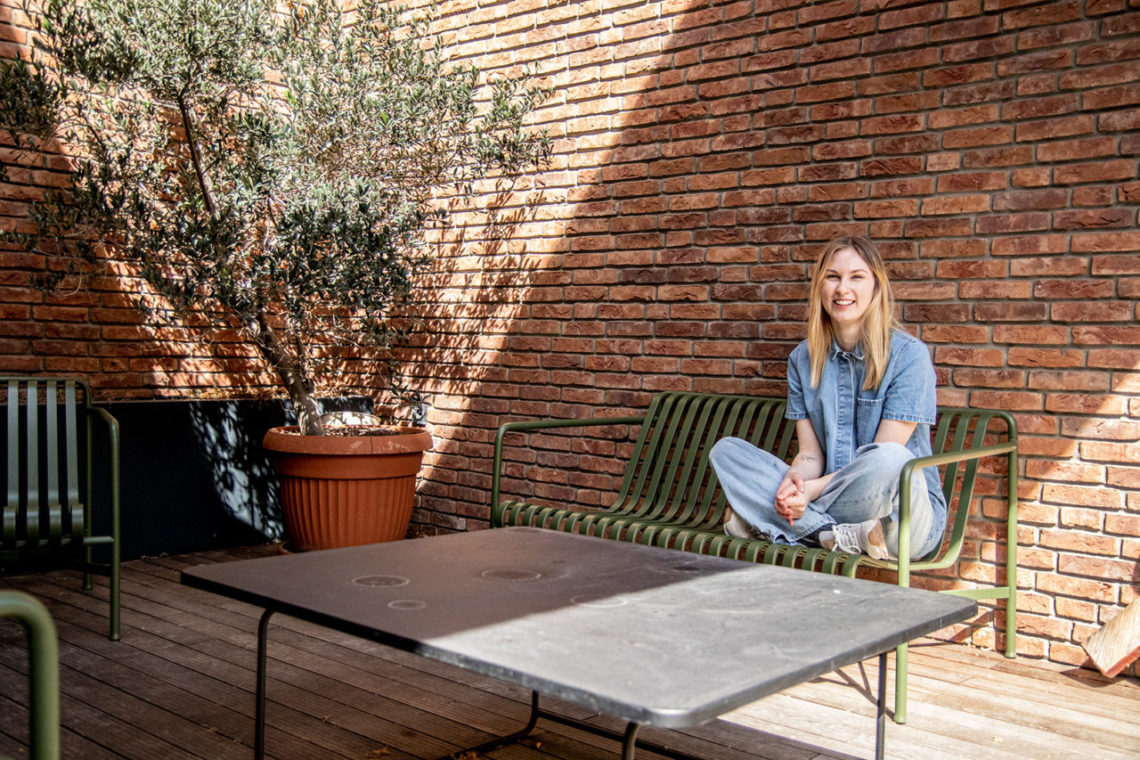
Did You reach your goals You wanted to reach before You came?
Yes I think so, my goals for this stay were basically to try something new, and learning about new culture and also working within cultural organization. I think I got the most out of my experience here, and I feel very happy that I could do all my projects and work here that I really like.
Can You tell me three things You will miss the most from Malý Berlín when You will be home?
Of course the biggest thing I will miss is probably the team of Malý Berlín, I feel like I’ve gotten so close with everyone during my stay and I will miss talking to everyone, and also I will miss helping with all the events and meeting Slovak people in this cultural space. But I will hopefully visit again in summer!
Ján Janočko
Photo: Petra K. Adamková
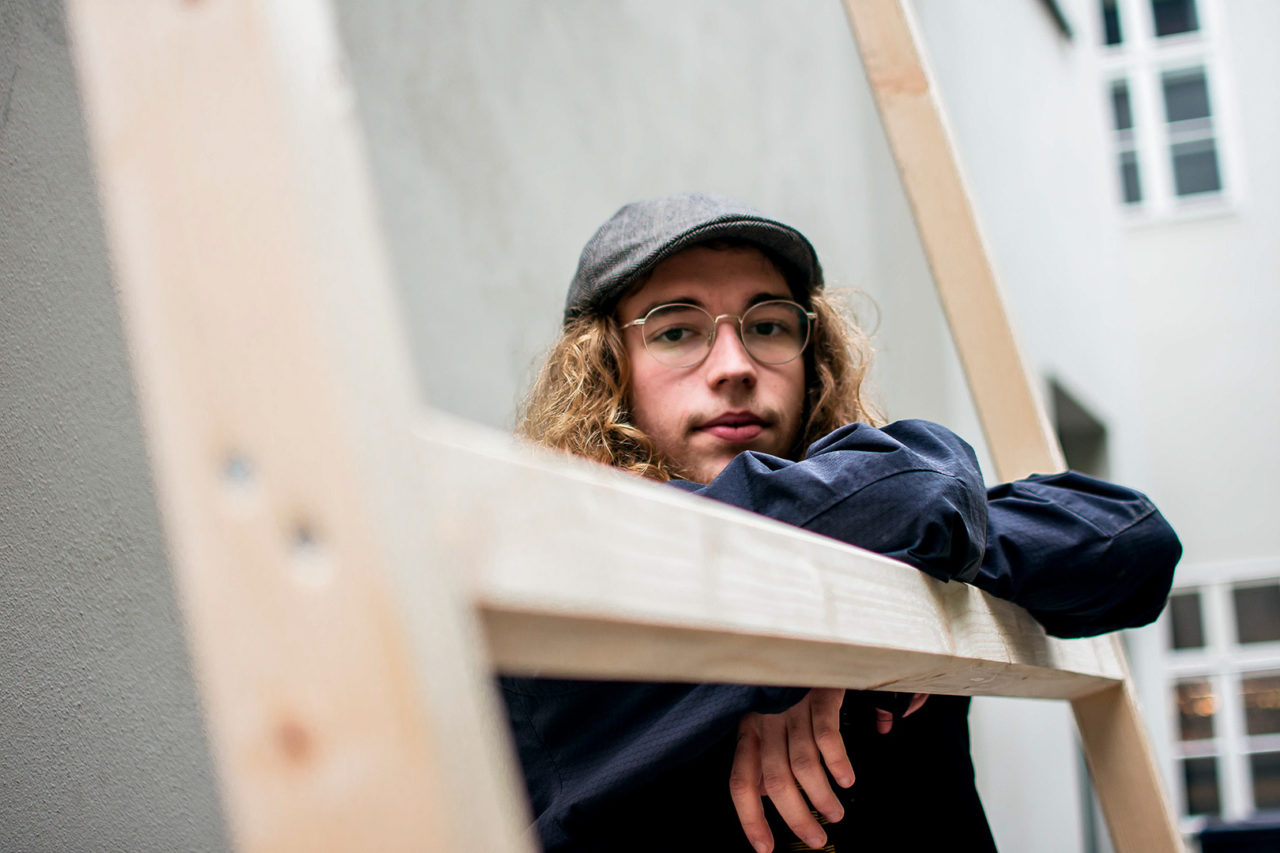
Painter Huba Hőnigh about the Sudoku exhibition: I got the best feedback from a small child
Until January 31, 2023, visitors to the Čepan Gallery (as well as those passing by) can look forward to an exhibition called Sudoku. We talked with the author of the exhibition, Huba Hőnigh, about how Sudoku was created, what preceded it, but also about drawing inspiration from, for example, a visit to Trnava.
How did you and your exhibition get to Trnava?
I got to Trnava by bike, airplane, car, and train. I got to know the opportunity through a painter friend Dávid Merényi, who introduced me to the curator Eva. She knew the Čepan Gallery and got in contact with the crew of Maly Berlín. I had to send her my portfolio, she sent me floor plans of the gallery and I made side-specific plans for the exhibition.
This is your first time in Trnava. How did you like the city, the gallery, and the people that helped you with the exhibition?
I was amazed, the team was very professional, the 50 meters of wood was already waiting for me in the gallery when I arrived. Everyone was super helpful and if I needed anything they just got it for me almost immediately so I could work very efficiently. I only had to focus on the artistic parts,on the technical part they helped me a lot. I really enjoyed that I was free to do whatever I wanted. I could even use the courtyard to make installations, and also could paint on the walls inside, which was a very good opportunity for me to try out new things. I think we need more places like Maly Berlin.
The tech guys Jozef and Michal were very helpful. One night Jozef was helping us until 1 am. Finding the right spots for the lamps around the courtyard and giving me an introductory lesson to the world of lamps. During the four days of installing, preparing I was in constant workflow. I also found the city pretty interesting, when I had some free time I walked around in the parks.
I took some photos, which I already used in some of my new paintings in Gröningen.The old city wall, the houses, windows were in good condition and gave a very nice view. I got good vibes from the city.
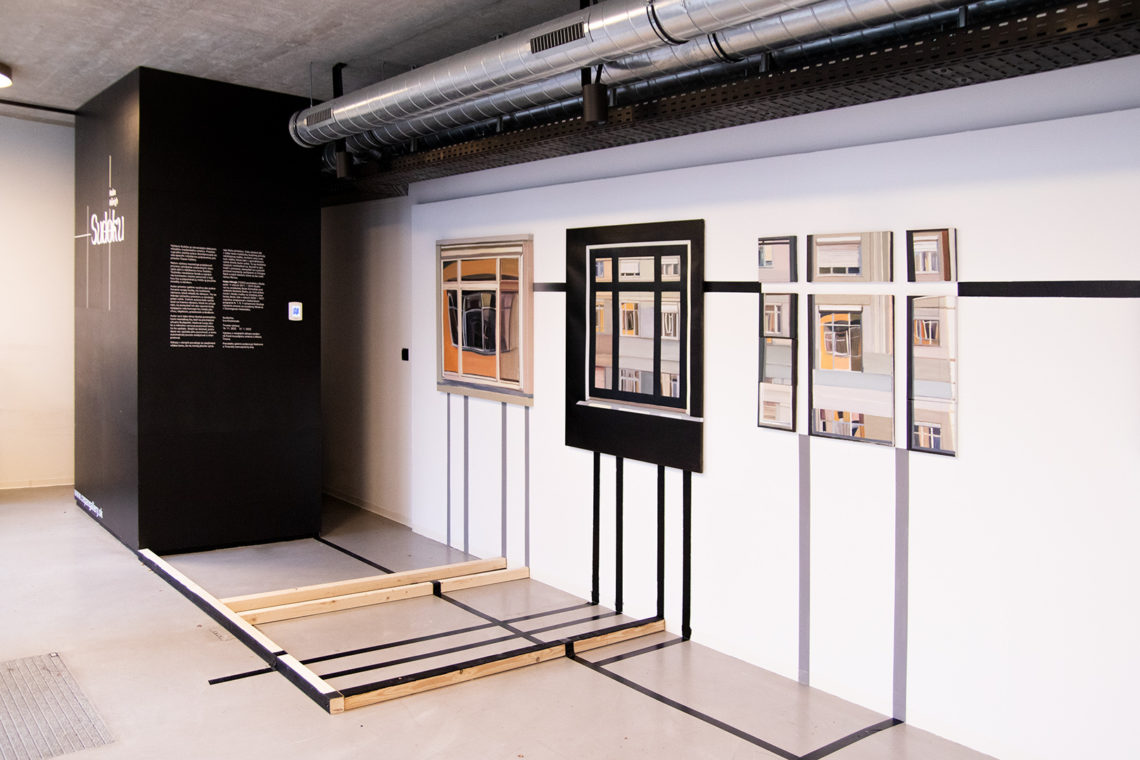
What kinds of feedback did you receive on the exhibition?
I got some very positive ones, both from the audience and the gallery organizers. It was already a good one that everyone followed the opening light-sound performance- that we made with Dani Németh- with great interest. I think my paintings represent traditional attitudes toward art and painting. With the gallery space, the outside, and the light system that Jozef gave me I think that I could mix traditional painting with something contemporary and unusual.
I also got positive feedback about the corporation of young Curators and artists. It is an aspect that should be more in focus I think. Young curators and emerging artists can work together with a great understanding. I hope the opening was exciting and enjoyable and that I could create a bigger unit out of my works in the context of the gallery space. I’m very happy that I got the opportunity to organize this exhibition.
The name of your exhibition is Sudoku and part of the creative process was playing your own game. Was this exhibition meant to be something that can push people to play their own games and look at the buildings in a new way and take more notice of the buildings they pass on a daily basis?
You summarized the main effect that I wanted to achieve with my Blocks and windows series.
The reason why I chose the title Sudoku is because playing sudoku is similar to the process of building up my paintings. For example if I talk about color mixing: I put red in the middle it will indicate that I can not use this color on this part. If I put number 9 in the middle of my sudoku that indicates that I can not use nine in different places.
Who is this exhibition for? I can see that a lot of different people can be interested.
For the older generation the more natural details on the paintings can be entertaining. People enjoy good craftsmanship and technical skills. The main concept was best understood by a small child, who started to play with the installations on the ground just as if he was on a playground. I think this was also the best feedback.
The kid could easily set up games for himself and have fun, it’s a harder task for adults. An exhibition could work as a free playground for the artist, and the viewers as well. In this context the artworks get closer and the experience gets stronger for the audience. I would recommend the exhibition to people who like to get involved in the view during the weekdays. I am searching for an order in the urbanistic landscape that presents a harmony of color and proportion. If you want to see my results, visit the exhibition at cepan gallery.
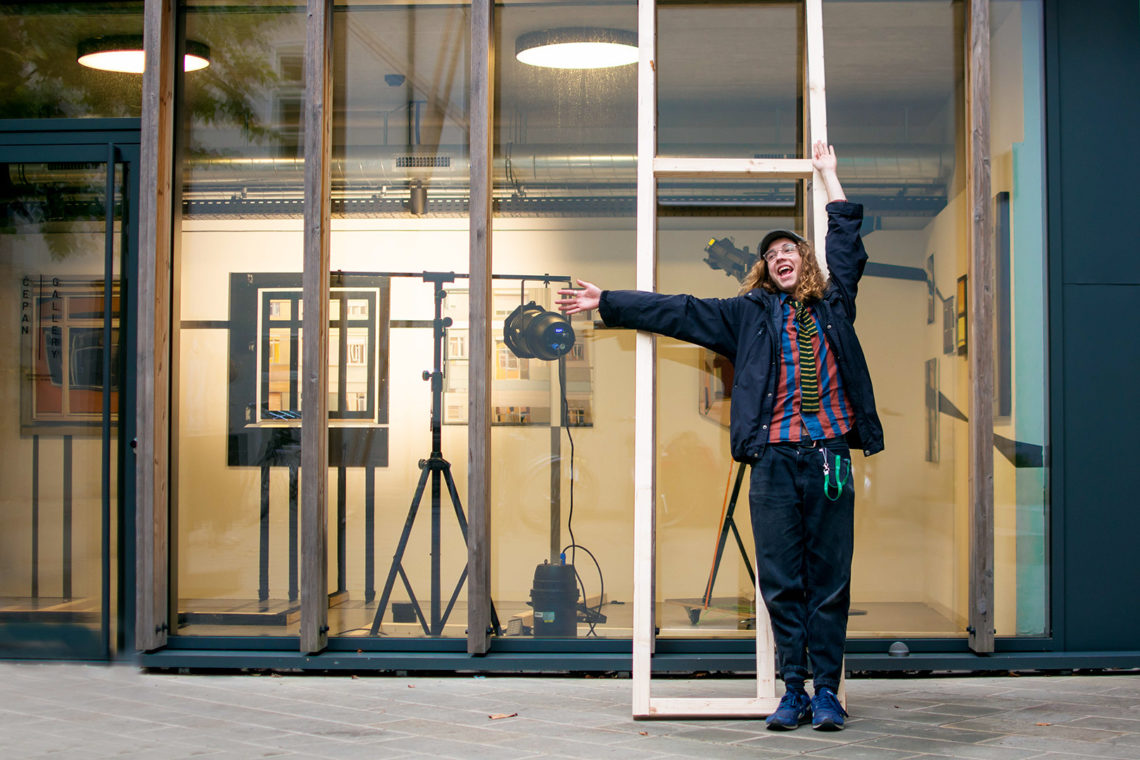
Do you ever look at the exhibition through a child’s eyes? Can it, maybe, make the exhibition better?
On my way to Slovakia I was thinking about what kind of new things I can try out that I can not do anywhere else. Trying out this unknown is a great play. In a child’s eyes this play presents their curiosity for the surroundings. That’s the act and way of approach that I want to reach. If the visitor can relate to it, it can make the experience more interesting but mainly this idea is important for me and for the making process.
Where do you get your inspiration from?
Looking and analyzing the way I see my environment. Having a walk in a new unknown city can be a good inspiration bomb. I had a few tours at Trnava as well, I might use my photos from here later on. Besides that, visiting exhibitions is also an important part. I think the artists that had the biggest influence on me are: Richard Diebenkorn, R.B. Kitaj, James Turell, Mark Rothko, Richard Serra, Haász István.
Do you ever consider coming back to Trnava and maybe make other exhibitions?
I had a really great time with great people here. I already considered making another performance with Dani Németh as a finissage. For the vernissage Danis sound design, music gave a lot to the experience of the exhibition. Due to the Christmass holiday it’s doubtful we’ll be able to make it for the second time, but I hope I can come back with other projects later on.
Do you have any plans on going to other cities to exhibit your paintings?
Right now I am living in the Netherlands, and most of my new work is there. I am going to show 3 paintings and a metal sculpture on the 2nd floor exhibition in Gröningen. It’s hard to transport work internationally although for now I could carry some smaller ones in my backpack to Trnava. I will have to figure out how it will work in the future. There are some plans for exhibiting at Budapest as well, and I am always searching for open calls, I already applied for some other open calls around Slovakia.
Ján Janočko, Rut Albin
Photo: Petra K. Adamková, Lívia Martvoňová

Oscar Brophy brings Irish comedy to Trnava: What can we expect?
21st november – a day during Irish comedy finds a temporary home in Malý Berlin. With one of the performers, Oscar Brophy, we talked about the specifics of standup from his homeland and why he chose Trnava as the next location for the show.
Why did you choose Trnava to be the place for your next event?
Because it is close to Bratislava and we would like to bring English comedy further into Slovakia. Of course, it is far away so it is like a stepping stone. I think in the future it would be cool if I say to traveling comedians that if you come to Slovakia, you can come to Bratislava, you can come to Trnava, and we can make a little circuit. We would have to make ourselves financially viable. Often comedians will come to Austria – Vienna, Salzburg, Innsbruck, and Prague, and then Bratislava is just a stop on the way. If we can make Slovakia a viable place for comedy, I think that would be cool.
You have already been here, in Malý Berlín, last May. How did you like it?
It was good, but it was weird that everyone had masks on, and it had reduced capacity, so I would like to see the show sold out. You have a nice venue and you are very cooperative and eager to have us back and have me back as well, to make new shows. That is always very nice.
I am really curious about Irish comedy. What makes Irish comedy “Irish”?
The first word that comes to mind is “absurdity”. British comedy is more about irony, but in Ireland, I think we are more about making jokes about silly stuff. Generally, we tend to be a bit silly on stage and make more fun of the oddness of life. There are a lot of different schools. Obviously, I talk about weird stuff. Terry is also very freewheeling, he covers a lot of different topics.
Tell me please more about Terry. I read about him, that he’s the next big star and he is becoming quite popular.
Terry is already headlining basically every show he does. He is headlining in Dublin, Berlin, Prague, and Vienna, and is a very talented comedian. I met Terry 3 years ago on the stage, it was just before New Year in 2019 and we were doing a show in Limerick. I met him the first time online on Facebook, and also when I was doing shows in Bratislava I was trying to get Irish comedians to come over and he was one of them. I got him over at the same time as this other guy called Joe Rooney, who is a famous Irish comedian. He was in the Irish show “Father Ted”. Terry ended up liking Bratislava so much that he lived there for a year, and he met his fiance Jenny there. He is one of my best friends.
So you did not know him from the times you lived in Ireland?
No, we have a sort of multinational friendship. I meet him when I visit Prague, and we hang out in Ireland, like when I was there over the summer. Terry is the tour manager for “Three Bucks Left”. It’s these guys from a tv show aired in Ireland during the early 2000s called “Hardy Bucks”. They are similar to Trailer Park Boys, and they are quite famous in Ireland. Terry is managing their tours across Ireland and the UK and is even bringing them to Vienna and Germany next month at the start of December. He’s just 26 and Terry has achieved a lot. He’s very hard working and he travels loads.
So he will bring the specific Irish comedy and there will be a lot of nonsense, kind of “Kafka stuff” and things like that?
I would not say Kafka stuff, it is more about relationships, sex, Irish Republicanism and being in foreign countries. It is also about being an Irish person abroad, something I relate to as well, and going into things with an Irish attitude.
So, just to be clear, this show is for foreigners or anyone can come and anyone can relate?
Anyone can come. If we were to be in Ireland we would be performing other stuff and different references but 99 percent of my shows have been in different countries, and with a diverse audience including all sorts of people. So you do not have to be from anywhere specific to understand our humour you just have to understand English.
Any last words, any last invites?
It is going to be great fun! Neither of us is working early the next day so I can picture us getting quite drunk after the show. If you want to have the fun of coming and seeing real live Irishmen, maybe you have only heard about us on the news, we are nice people so you can come and have the „craic” with us as we say in Ireland!
Will you tell people how you, the regular Irishmen came to Slovakia and stayed there for 6 years?
I will definitely get into it, I will not spoil anything now, but I will get into my story and how I got here. It does not make sense really. I should not be here, but I will tell you all about it!
Ján Janočko